How to Manage Contacts
You can track your work with contacts, view your interaction history, and see the progress of work with your deals. If necessary, you can manually add new data, leave comments, or contact the client directly.
Contacts are automatically created when you add them to
The contact is identified in all SendPulse services by matching the main email address. If during sending a contact to CRM, duplicates are created, you need to merge them into one contact.
How to Add a Contact
Go to the "Contacts" section and click Add contact.
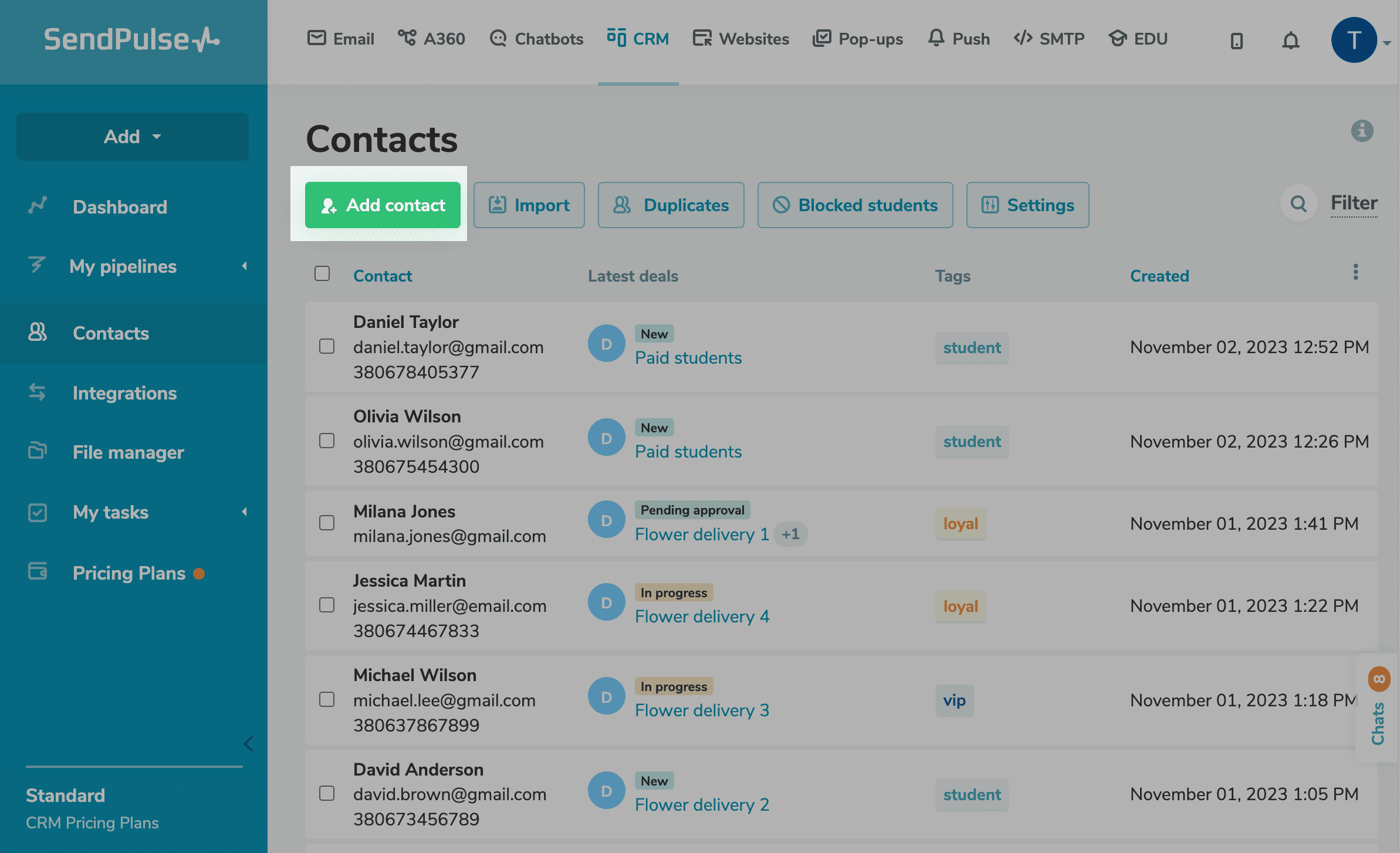
Specify Contact Data
Enter a contact name and the contact’s data. In the "Messenger" field, you can insert a phone number or username in the messenger. When you click on the icon you will be redirected to a specific messenger to chat with your client.
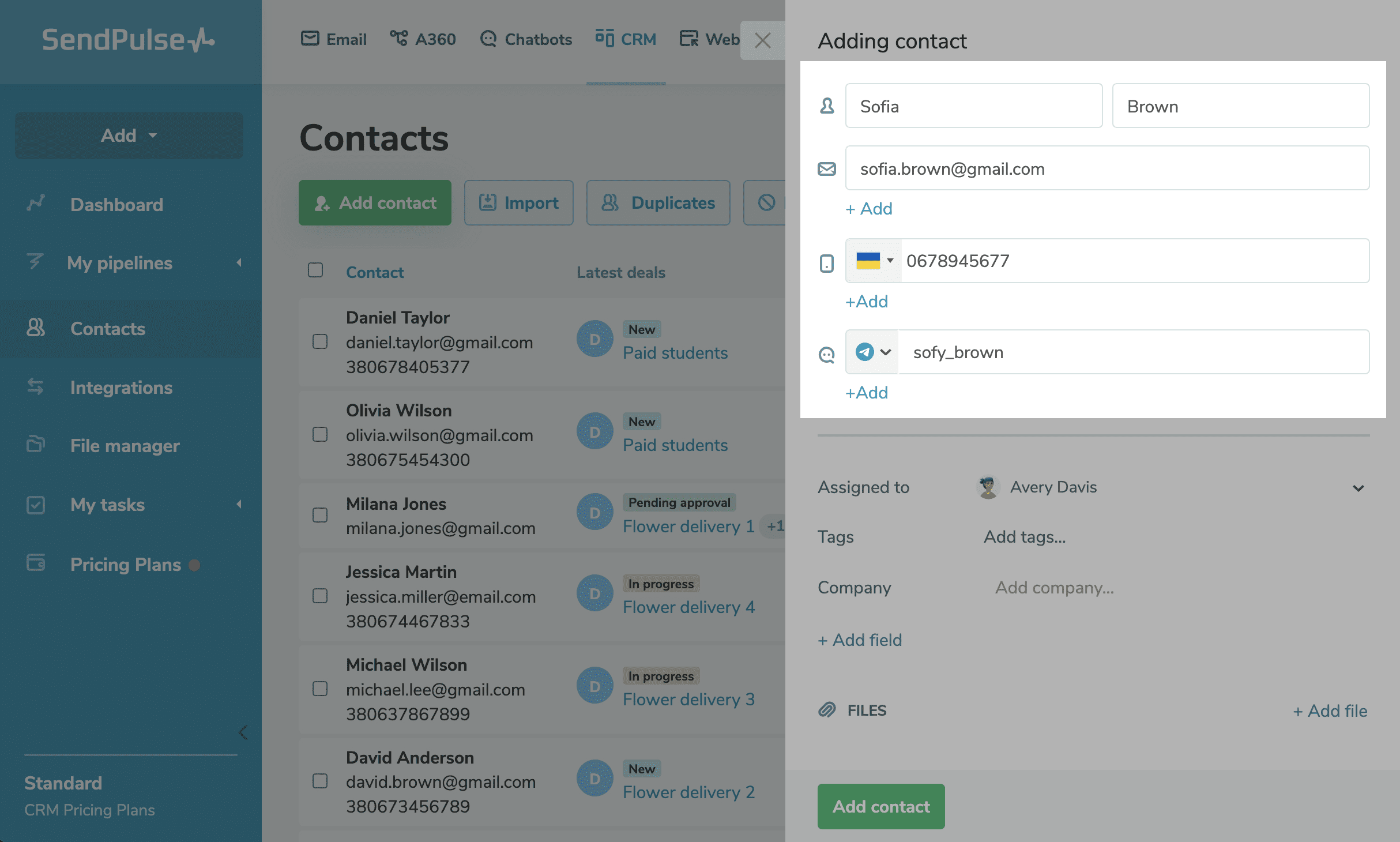
Assign a Team Member
Select a team member to assign to manage this contact.
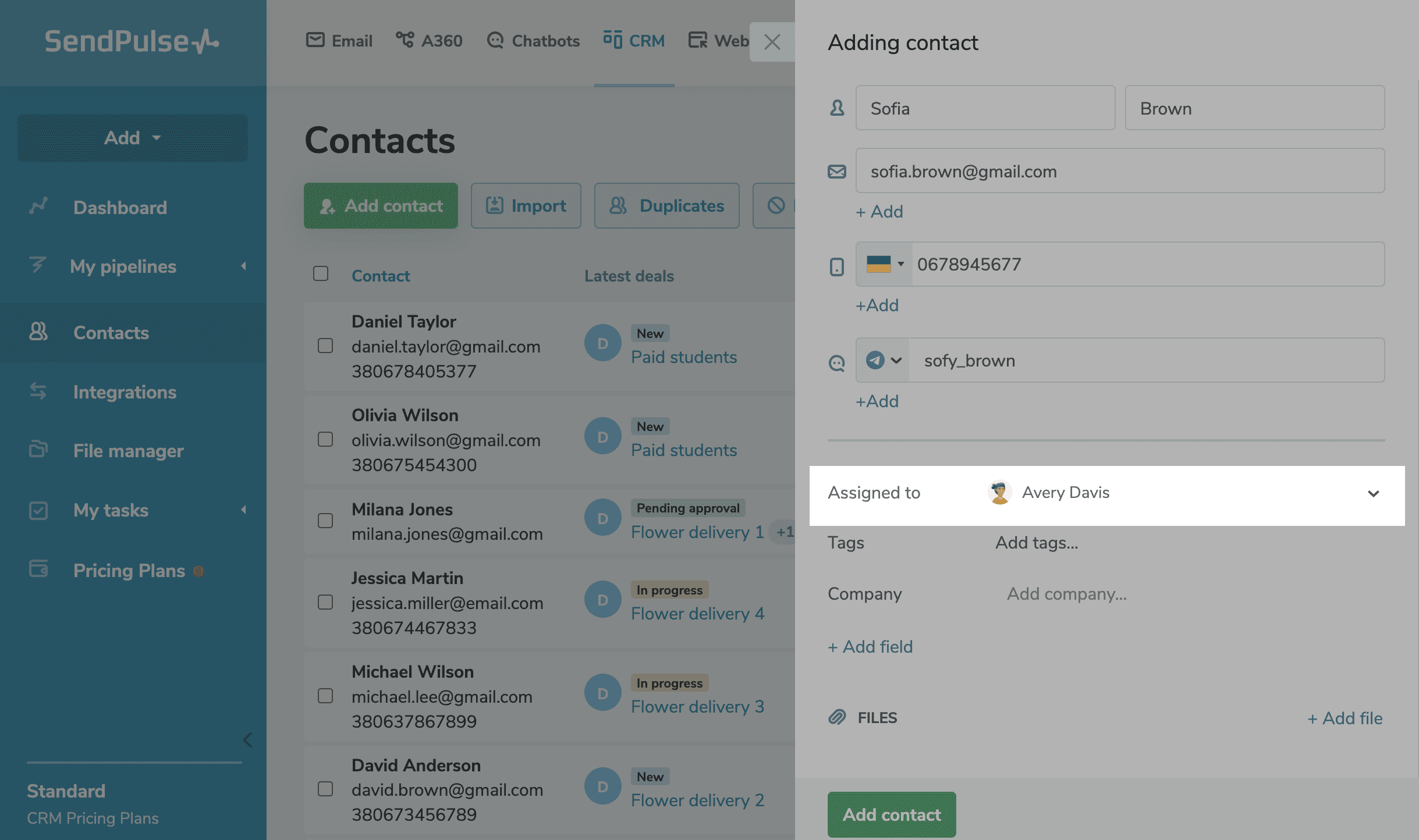
Add Attributes
You can also add attributes for the contact: add tags, fill in fields or create a new field.
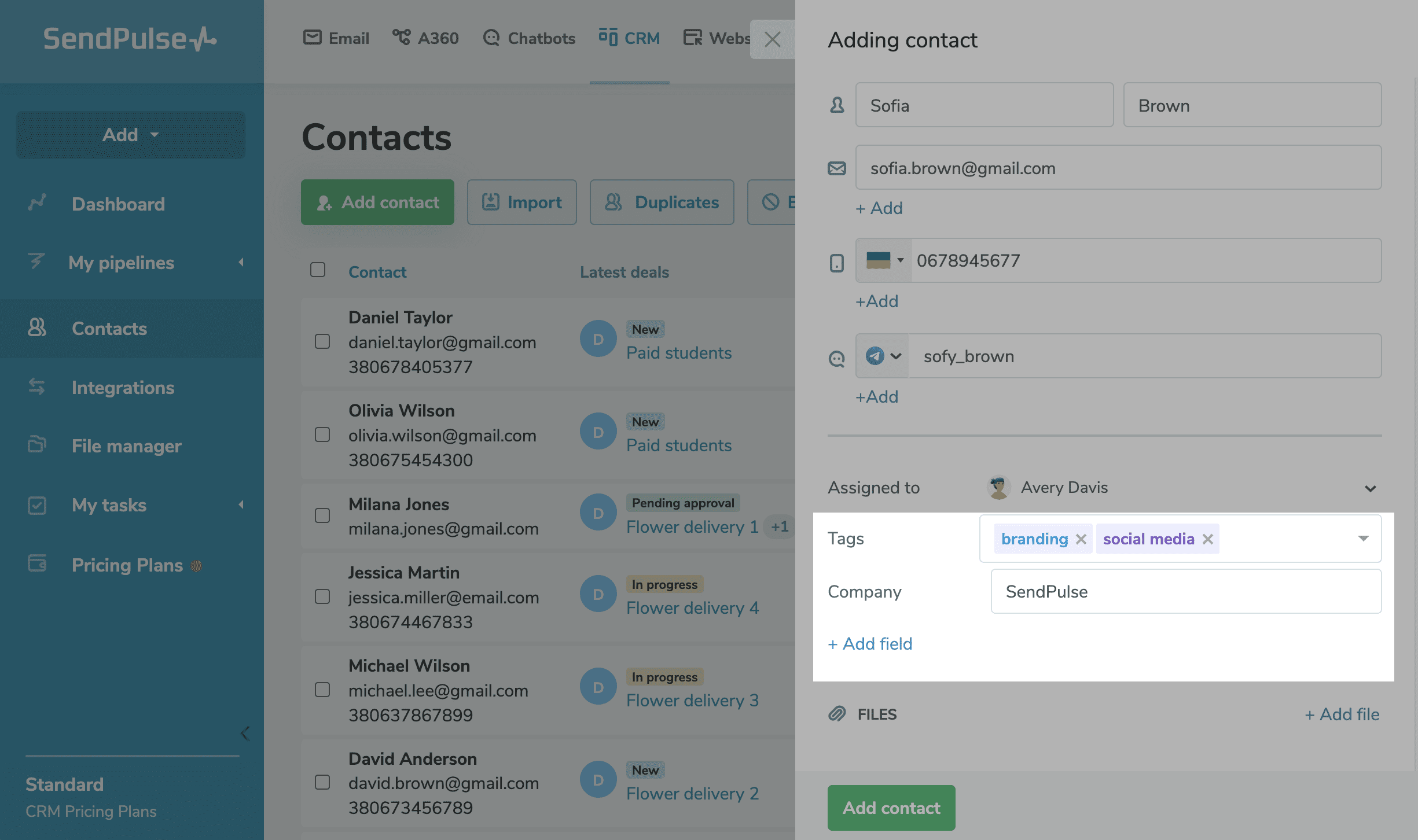
To add a new field, click Add field. Then, enter a name and select the field type. Check if you want to make the field mandatory.
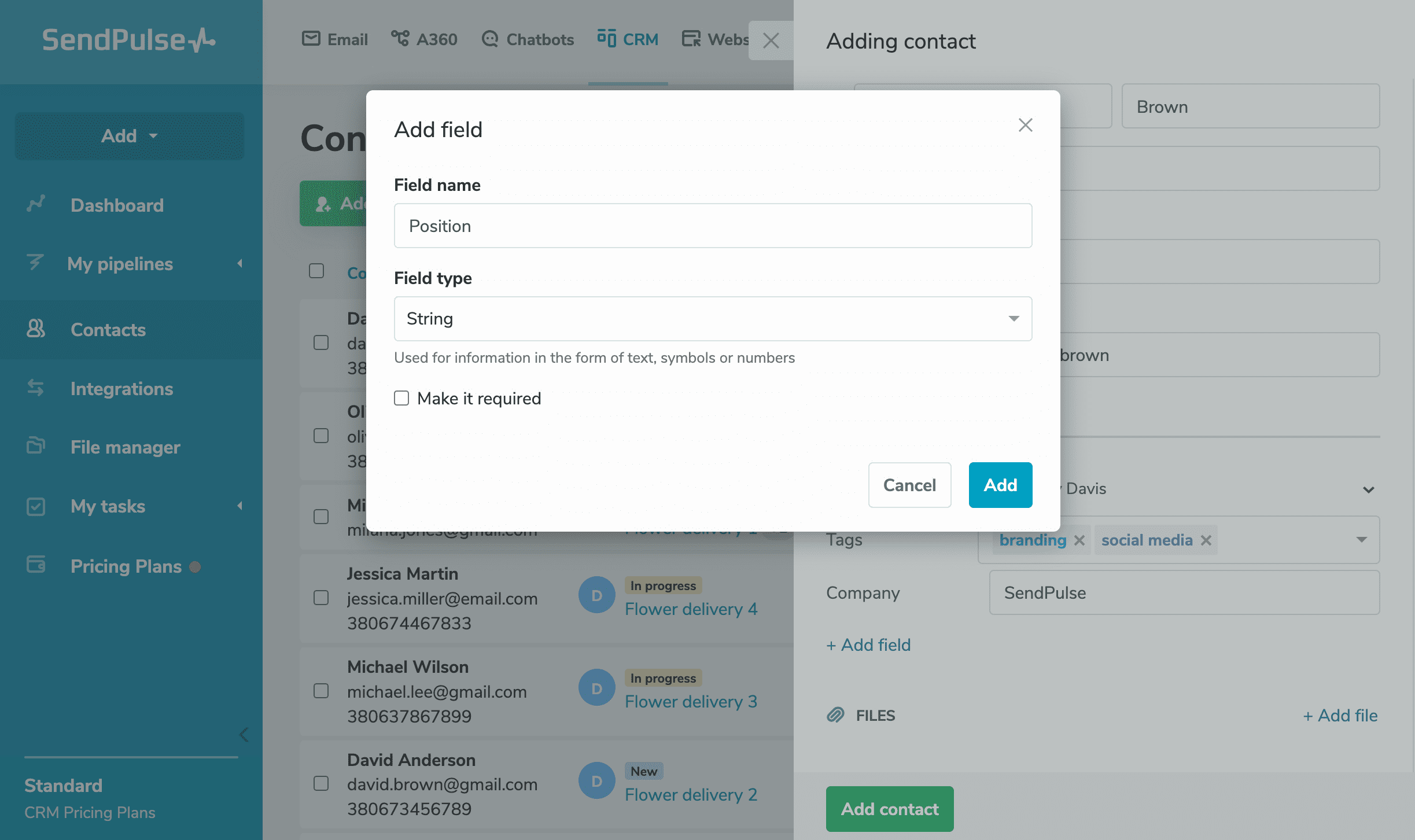
Add File
You can attach files to a contact to share them with all its members. Click + Add File, choose a file from your account storage, or upload a new file from your device.
All services share the same file storage. You can add a file of any extension except executable.
The maximum file size the free plan allows is 200 MB. Your file storage capacity is not defined by services but is set based on the storage capacity of the largest pricing plan among all services. To increase your storage capacity, upgrade your pricing plan. Read more: How to Work with the File Manager.
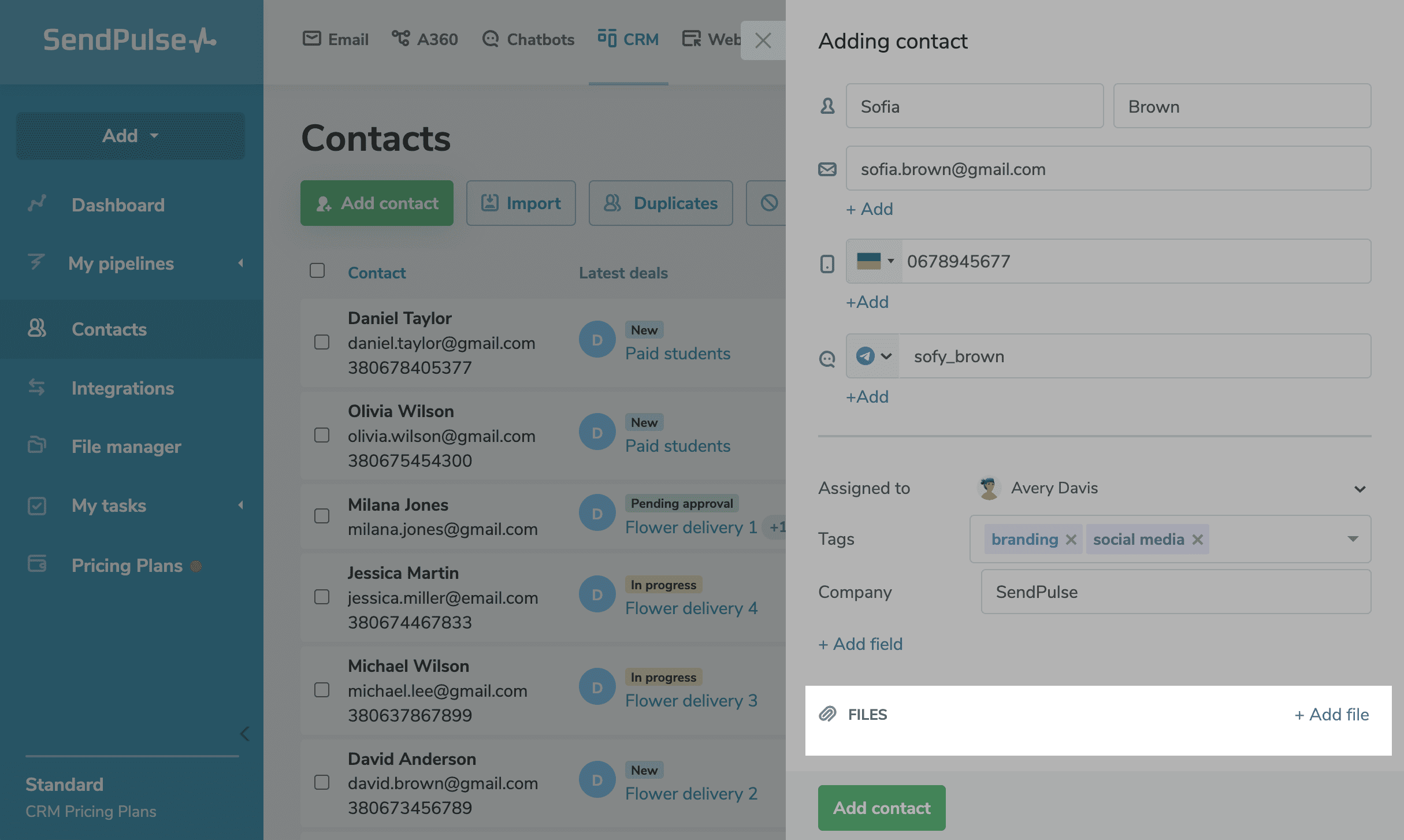
Click Add Contact.
Now the contact will be available for selection when you are creating deals.
Also, contacts in your CRM database are created automatically when creating deals.
How to View your Contact List
To view your list of contacts, go to the "Contacts" section.
This list displays all of the contacts that you created manually in the "Contacts" section, added when creating a deal, and those that were added with the automatic source of the deal.
On the page, you will see the name of the contact, their contact details, the number of deals to which the contact has been linked, tags, and contact fields.
Users can only view contacts as per their role settings.
Read also: How to manage team members.
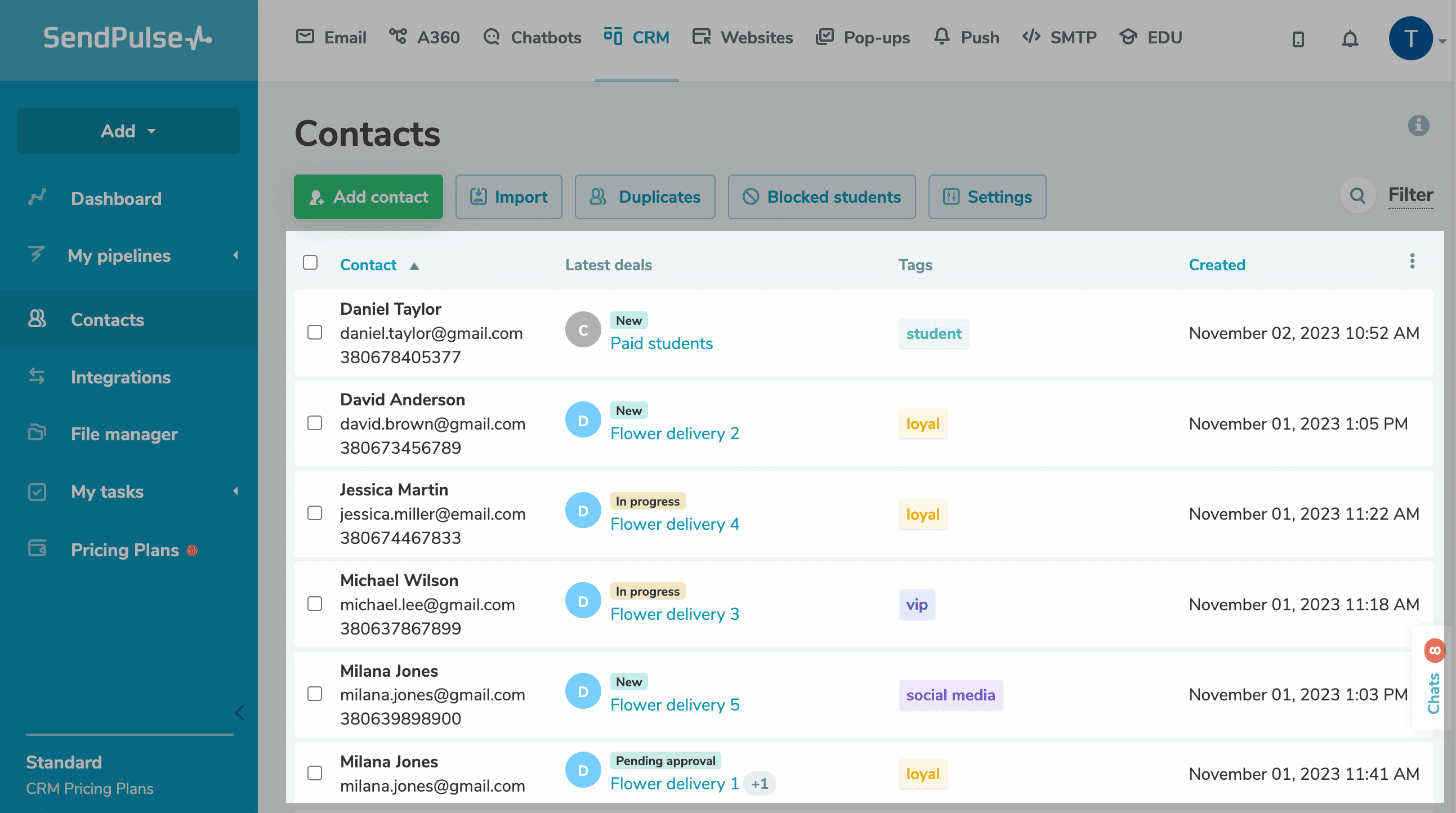
To show or hide contact fields, click on the three dots and mark the fields.
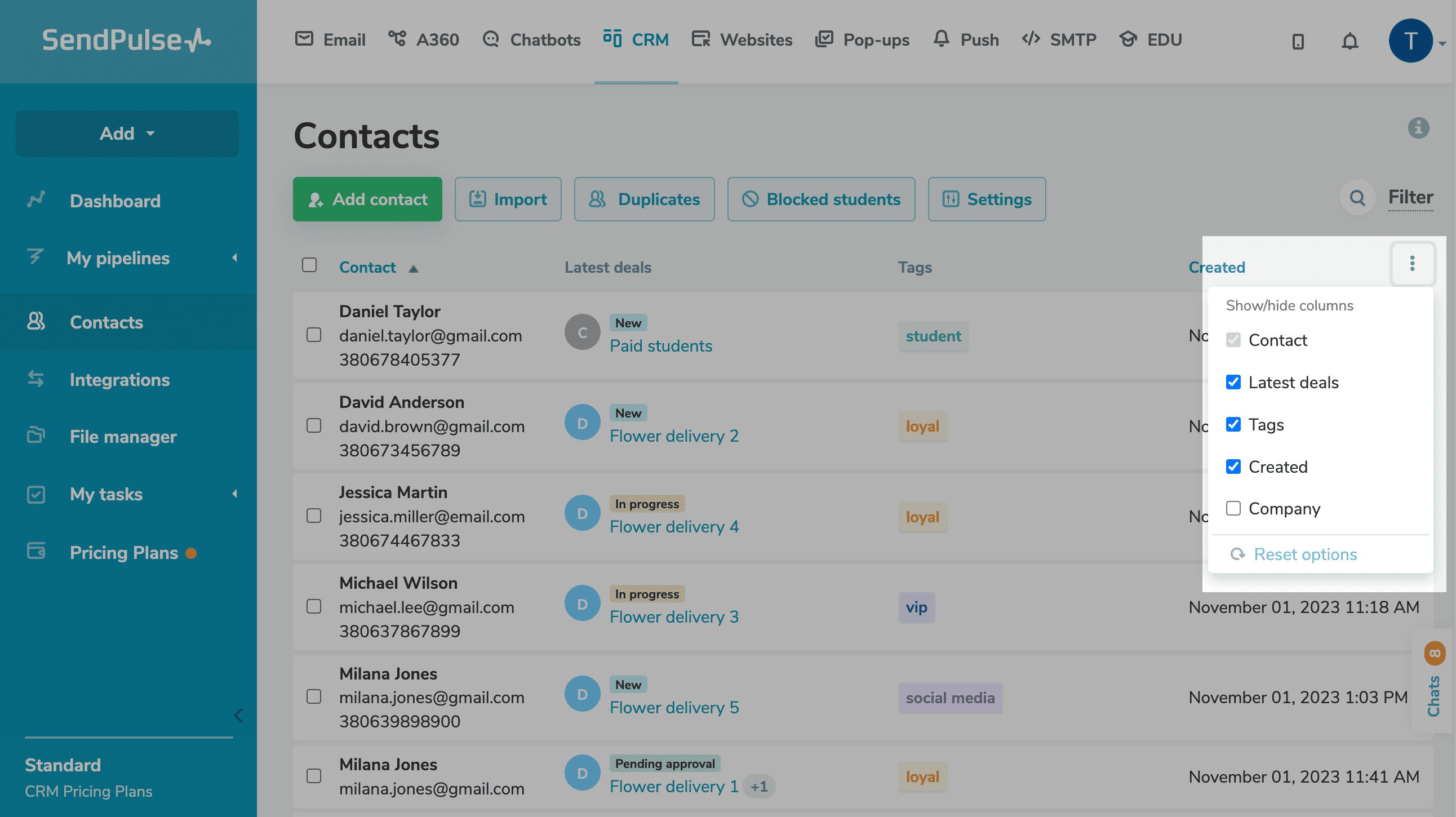
You can also remove duplicates among your contacts.
Read more: How to Remove Duplicate Contacts.
How to Filter Your Contacts
You can filter your contact list displayed on the screen.
To do this, go to the "Contacts" section, click “Filter”, and select the necessary filter criteria.
Filter Criteria
You can filter your contacts by the following parameters:
- date created: specify a time period, or select the "Last ... days" option;
- team member: select one or more team members assigned to your contact;
- source: select the source using which your contact was added (chatbot, subscription form, landing page, Automation360, payments, API, integration, or manually);
- first name, last name, email address, and phone number: enter contact details;
- messaging platform username and link: specify one or more messaging platforms, and add links to them;
- location: enter contact location and address;
- tag: enter the tag linked to your contact.
You can also filter your contacts by the fields you created for them.
If not all deal filter fields are displayed, click “Change filter fields” and select the filters you want to display.
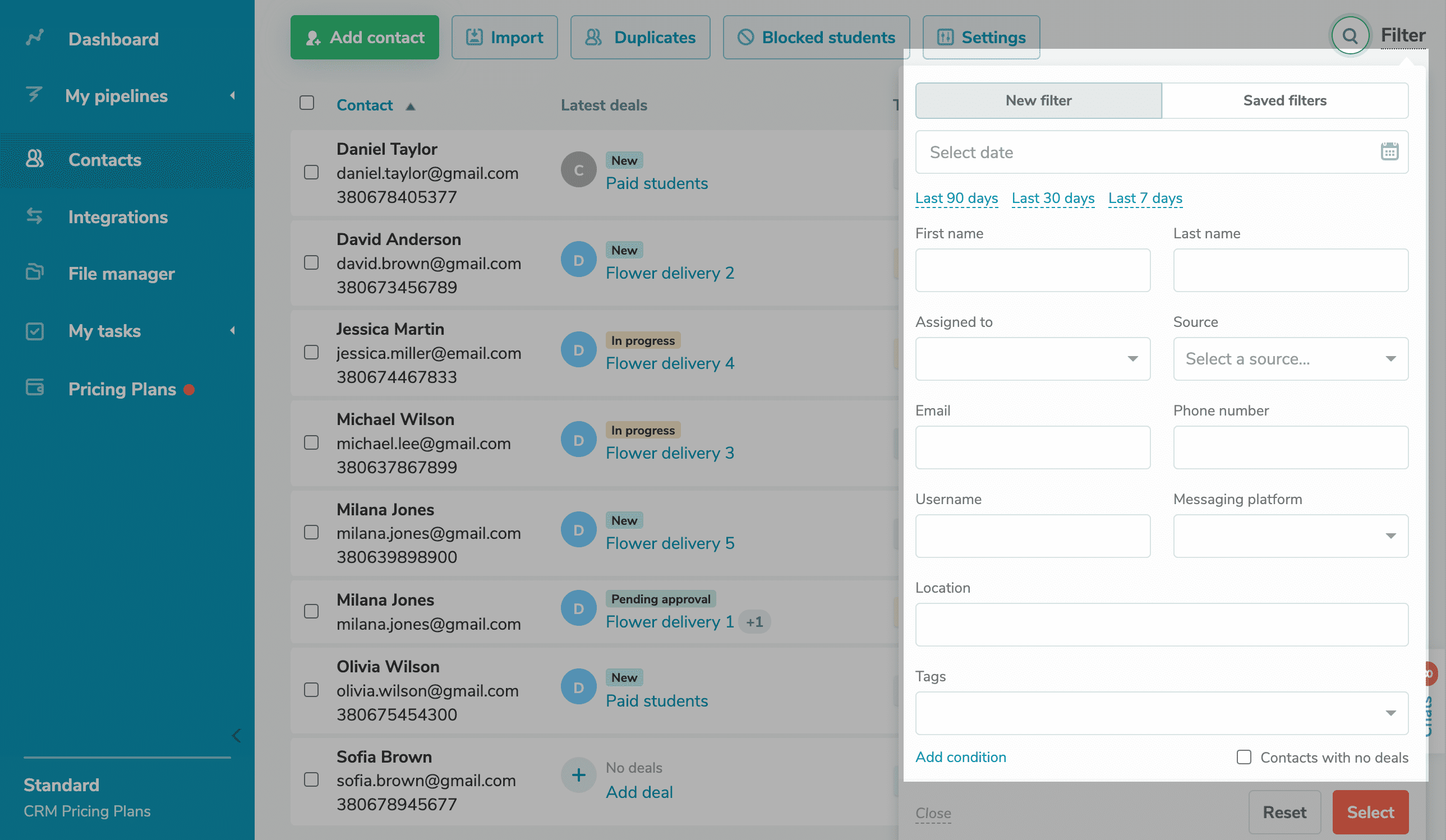
Quick Access to Saved Filter Criteria
You can also save frequently used filters to reduce the time it takes to find the deals you need. To do this, select your filter criteria, click Select, and go to the page with the filtered data.
Click “Save filter” and save your filter settings. Add a filter name to be able to quickly find it in the list.
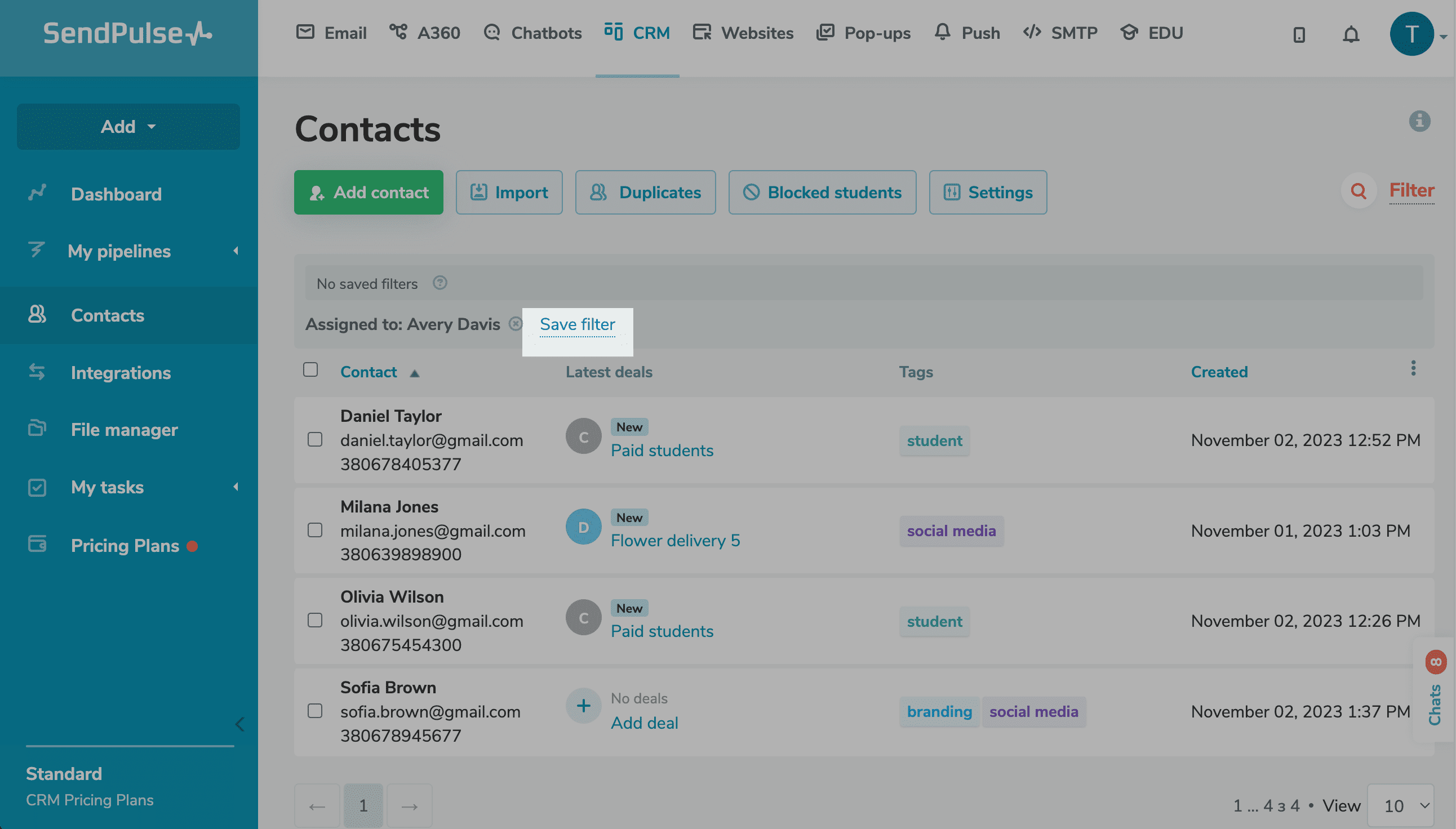
To use your saved filter settings, go to “Filter” > “Saved filters,” and select a filter.
How to Work with Contact Information
General
Click on a contact to view and edit their information.
You can edit the contact’s first and last name and view the contact source and date when they were added at the top of the contact page.
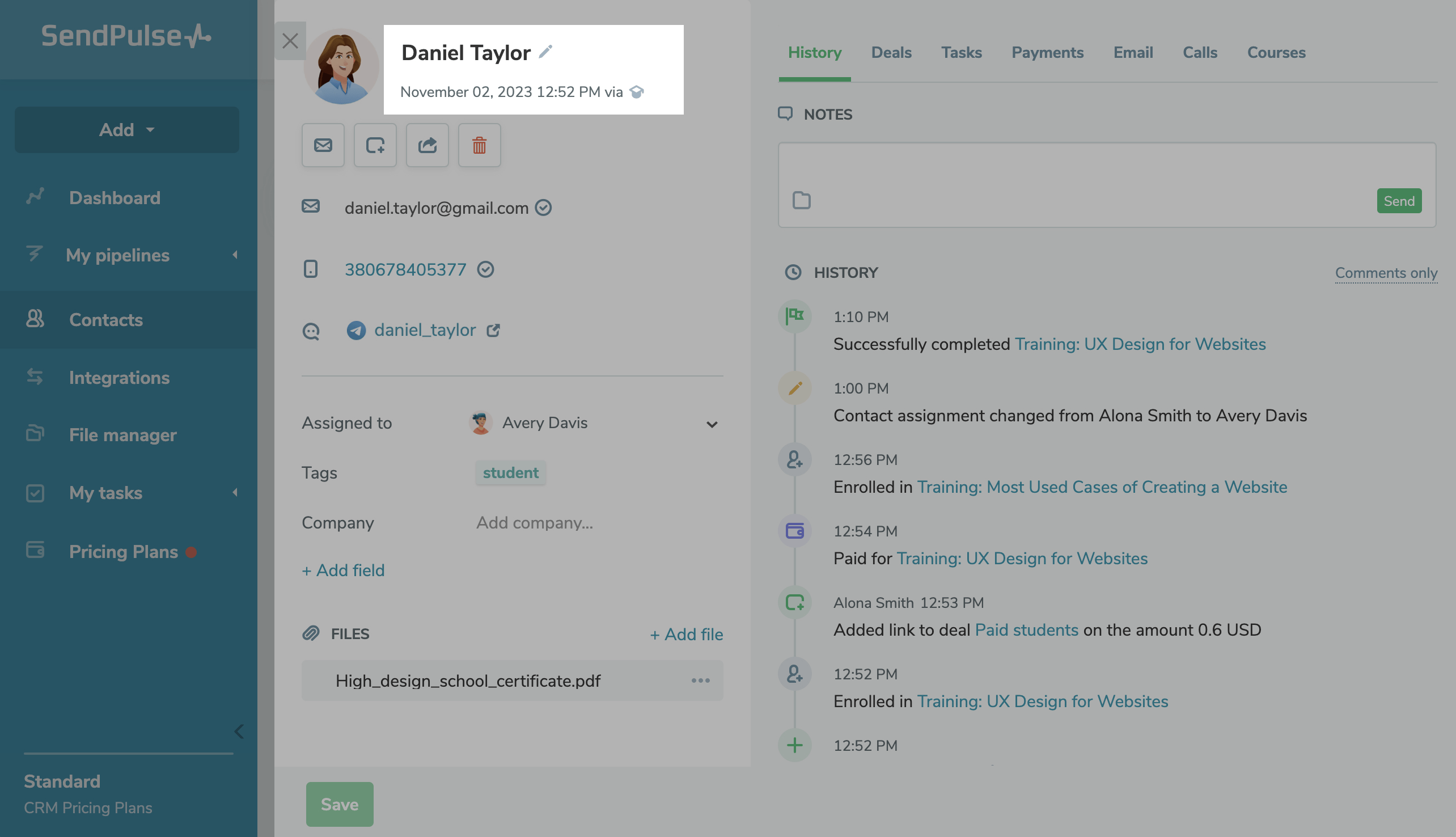
Contact Information
The customer's contact information is displayed below their name. If necessary, you can change the phone number, email address, and selected messenger profile to communicate with the client.
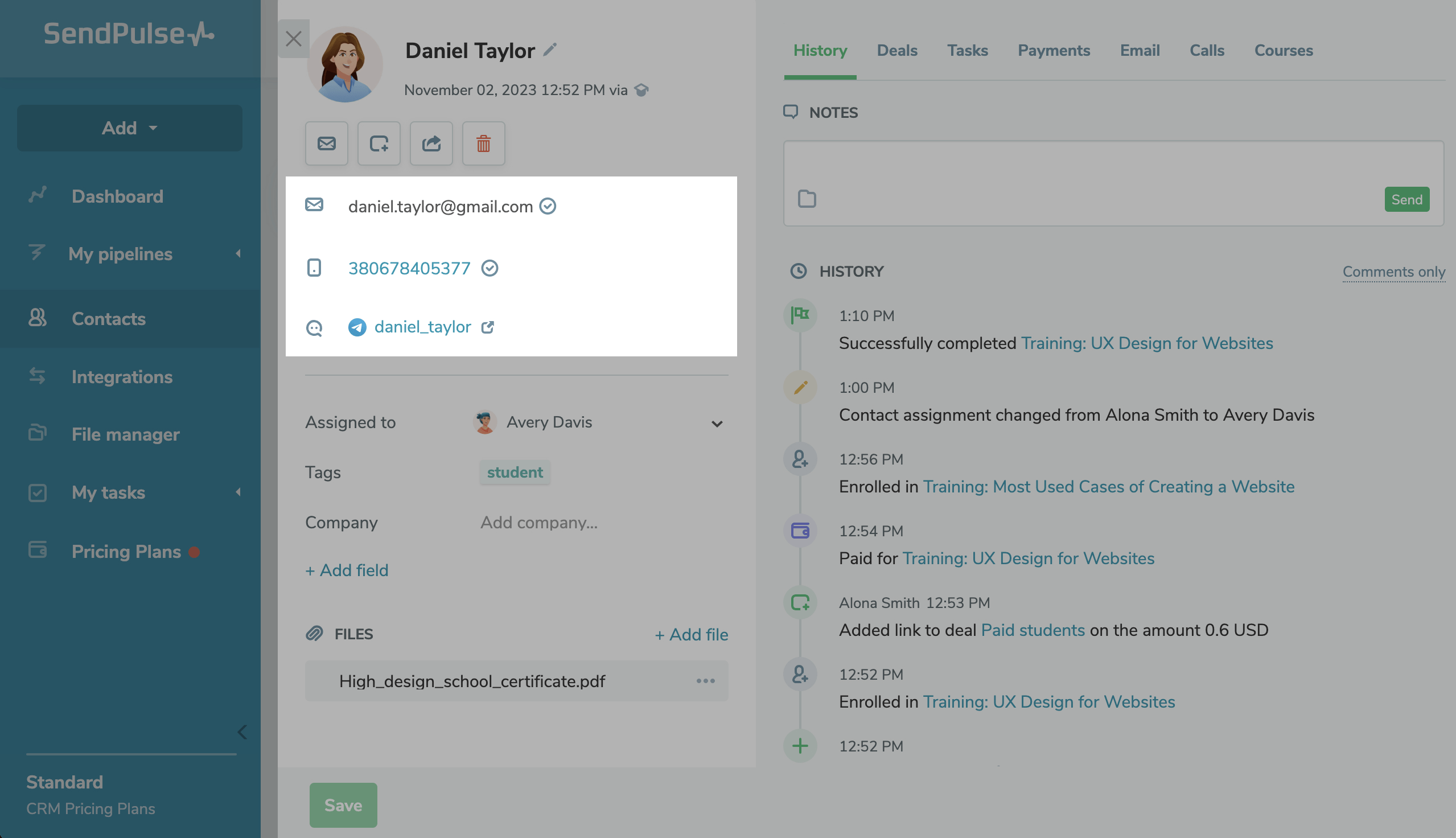
If you have several phone numbers or email addresses for one subscriber, you can mark one of them as primary. This will help your team members navigate loads of contact info easier and limit the number of messages triggered by events in CRM.
To do this, click the field where you have several phone numbers or email addresses, select one of them, and click Save.
By default, the contact info that was added first is marked as primary.
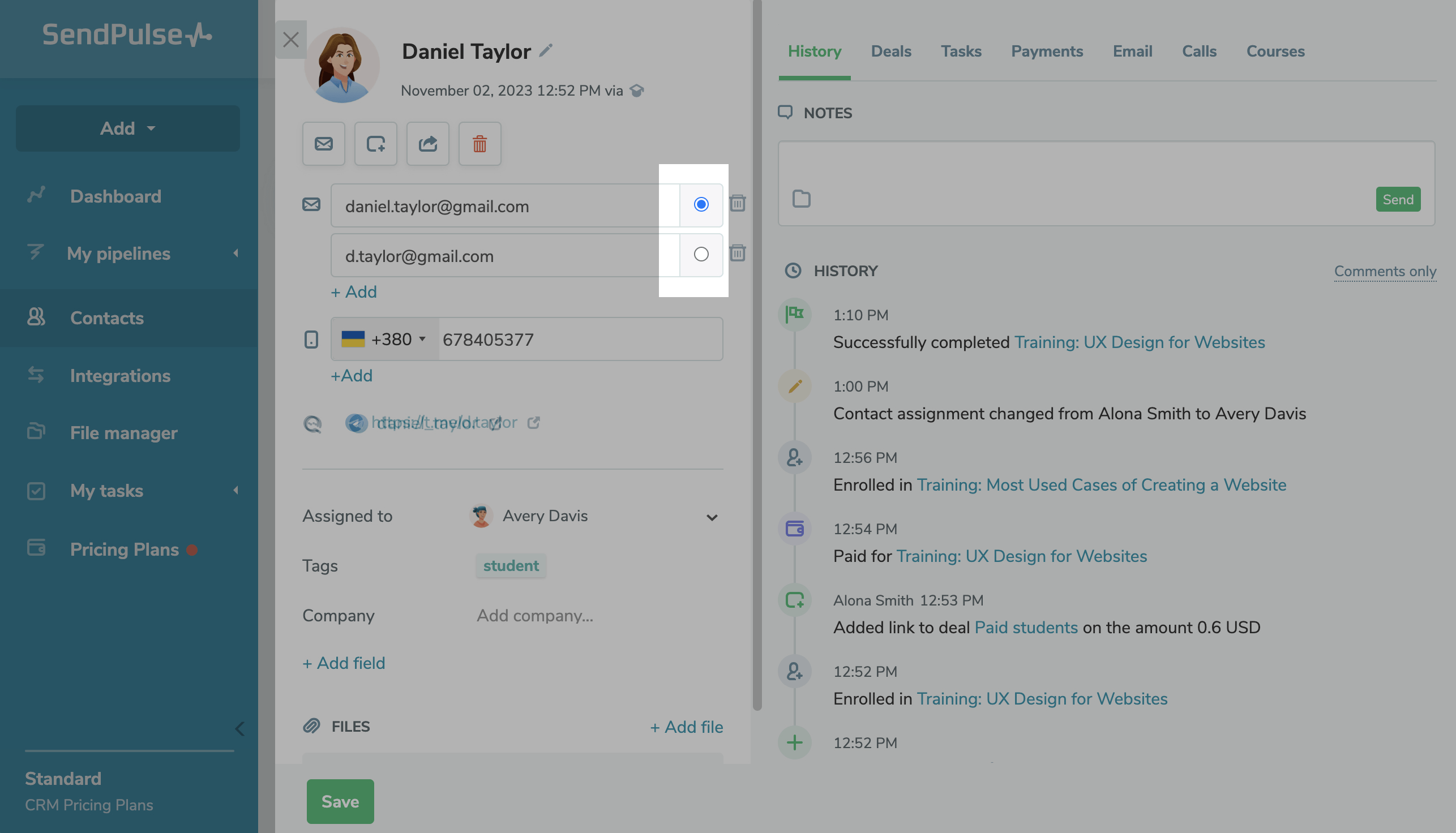
Team Member
You can also change the team member responsible for a contact.
Read more: How to Manage Permissions.
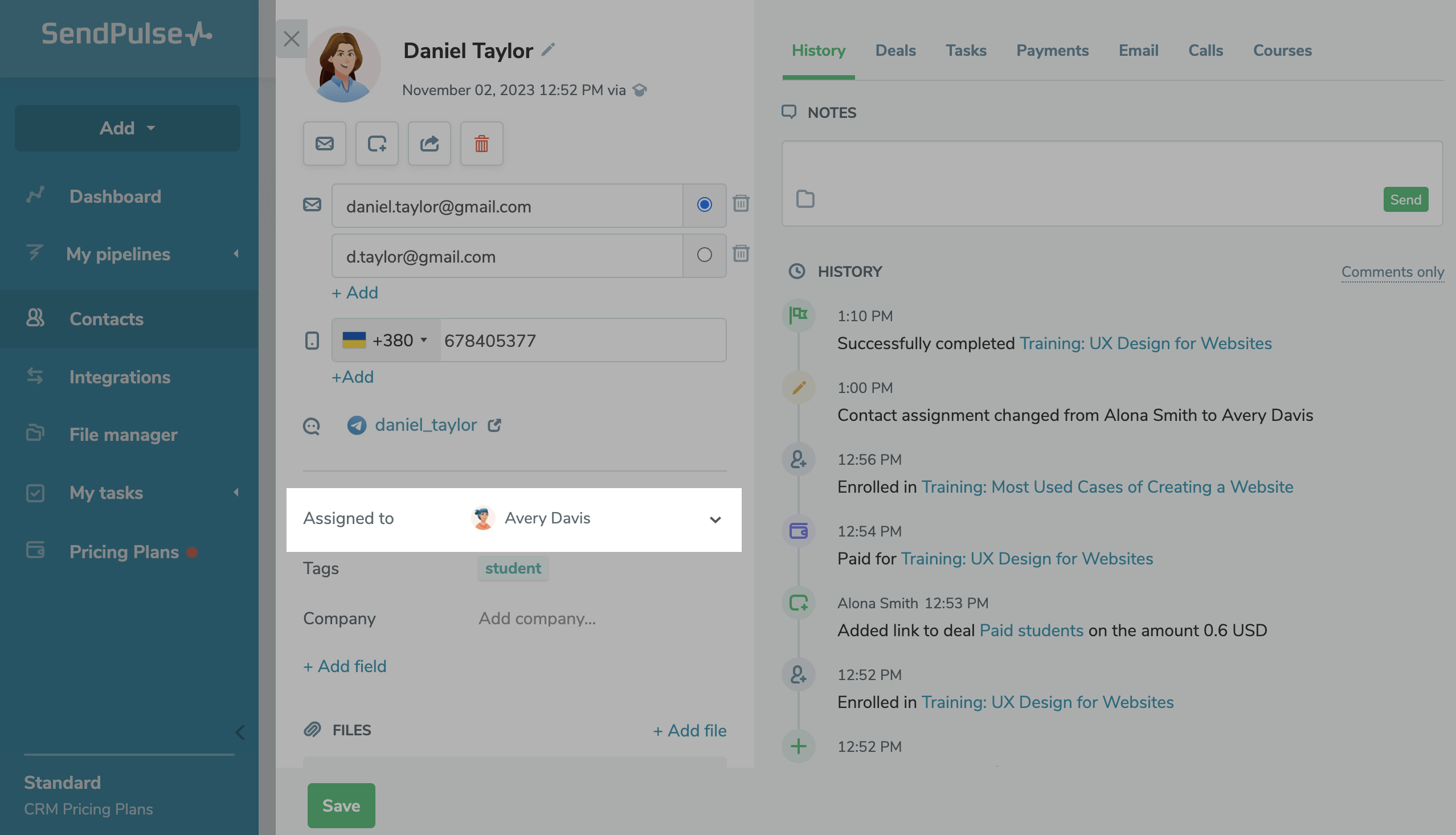
Attributes
You can also see the contact attributes. Add contact preferences and features to personalize your communication with customers via email, SMS, and chatbots. To do this, enter or select the value you see next to the required contact attribute, or create a new one.
Read more: How to Manage Contact Attributes.
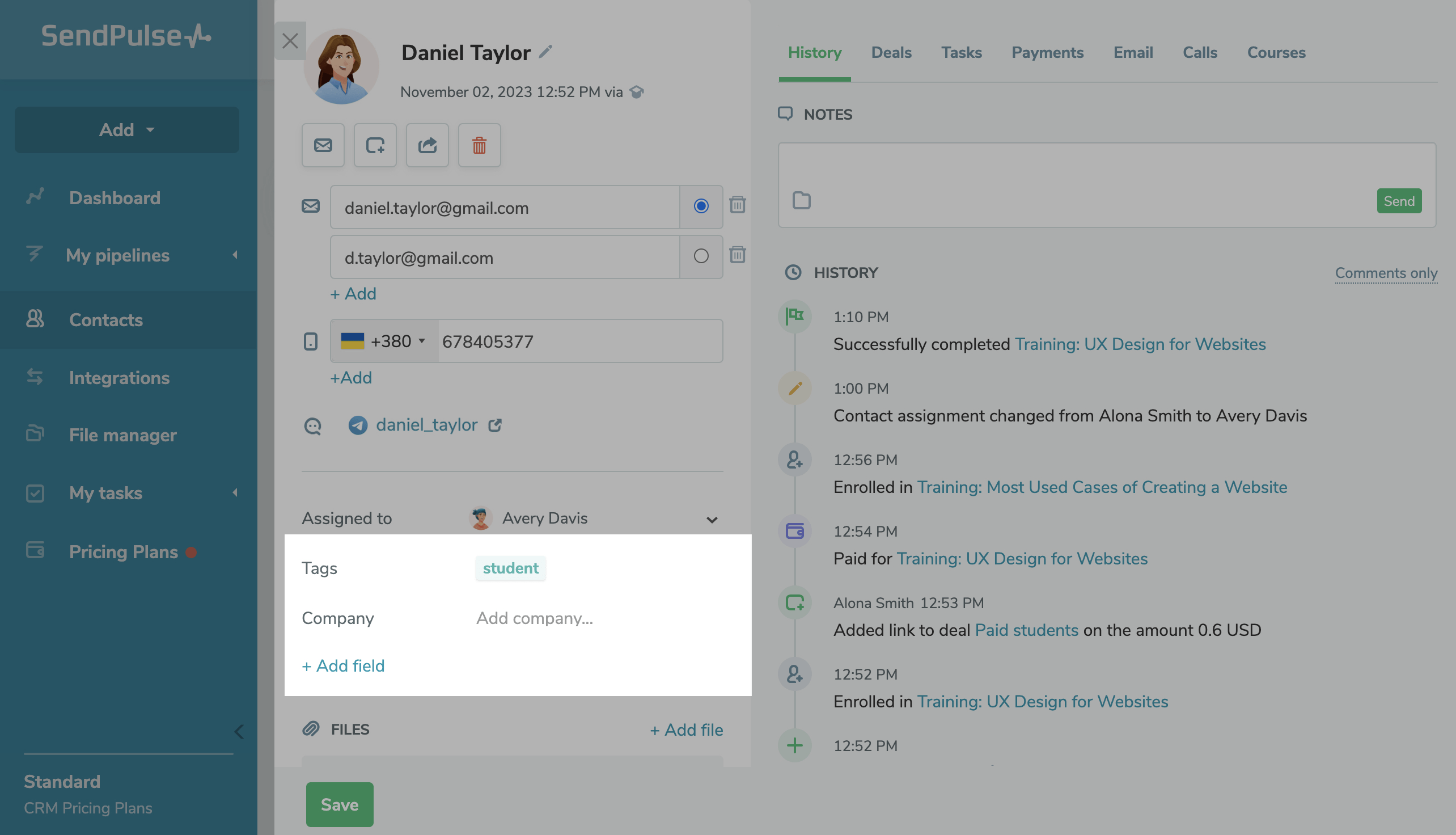
If a visitor goes to your website using a link with UTM tag fills out a subscription form on your SendPulse-based website, or registers for a course created with the “Courses” service, these tags will be transferred to the corresponding contact fields.
File
You can attach files to a contact to share them with all its members. Click the meatballs icon to manage your file after it has been downloaded.
| Download | Download the file to your device. |
| Show in folder | Show where the file is located in the SendPulse storage. |
| Remove from task | Remove the file from this task but not from the SendPulse storage. |
| Delete | Delete this file from the task and the SendPulse storage. |
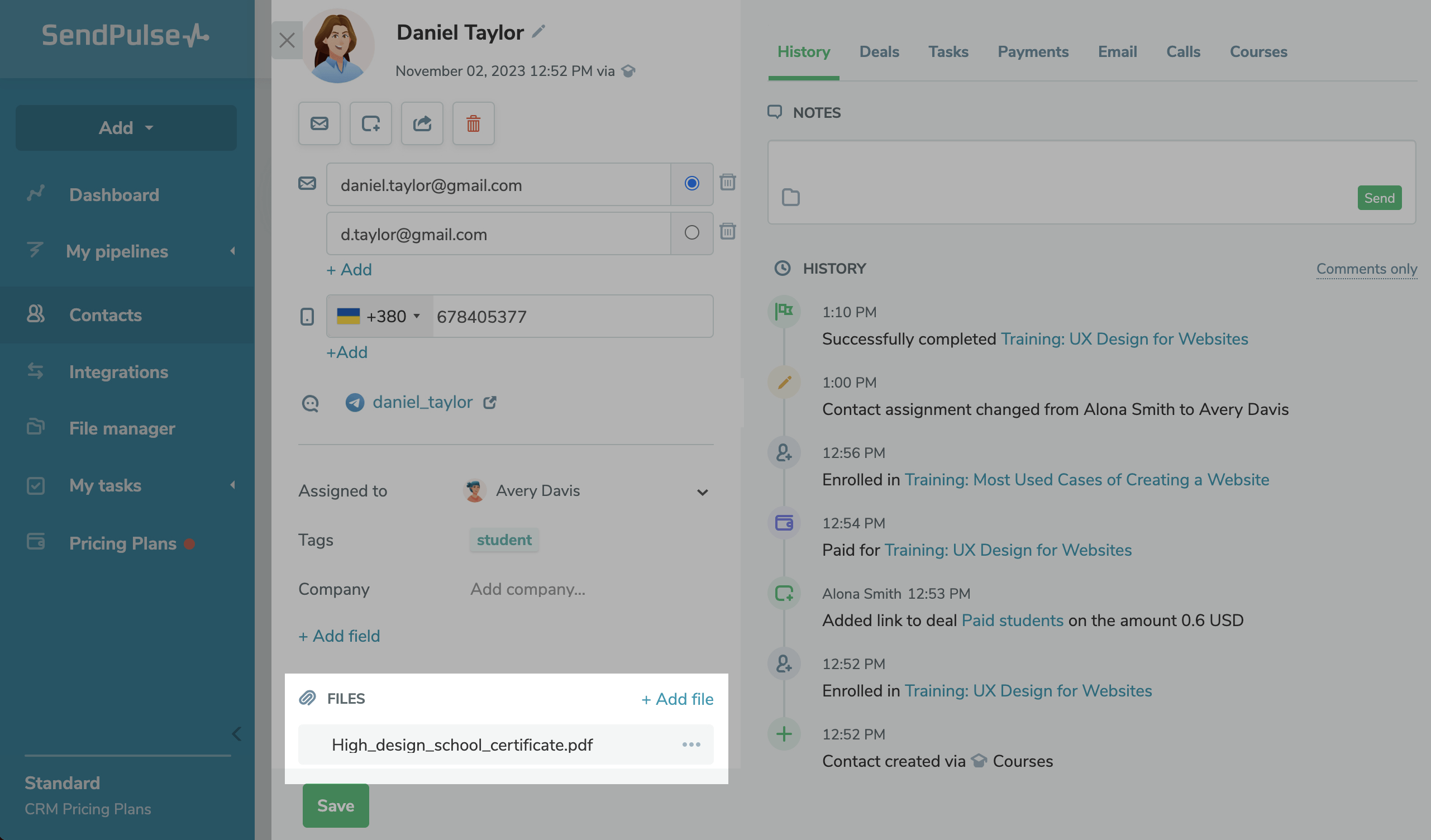
History and Comments
In the "History" subsection on the right, you can add comments about a contact, mention other team members, and attach documents. You can see the history of your work with the contact and your deal progress with all the comments below. You can choose to view the entire history or only the comments.
Learn more: How to Work with Contact History and Comments.
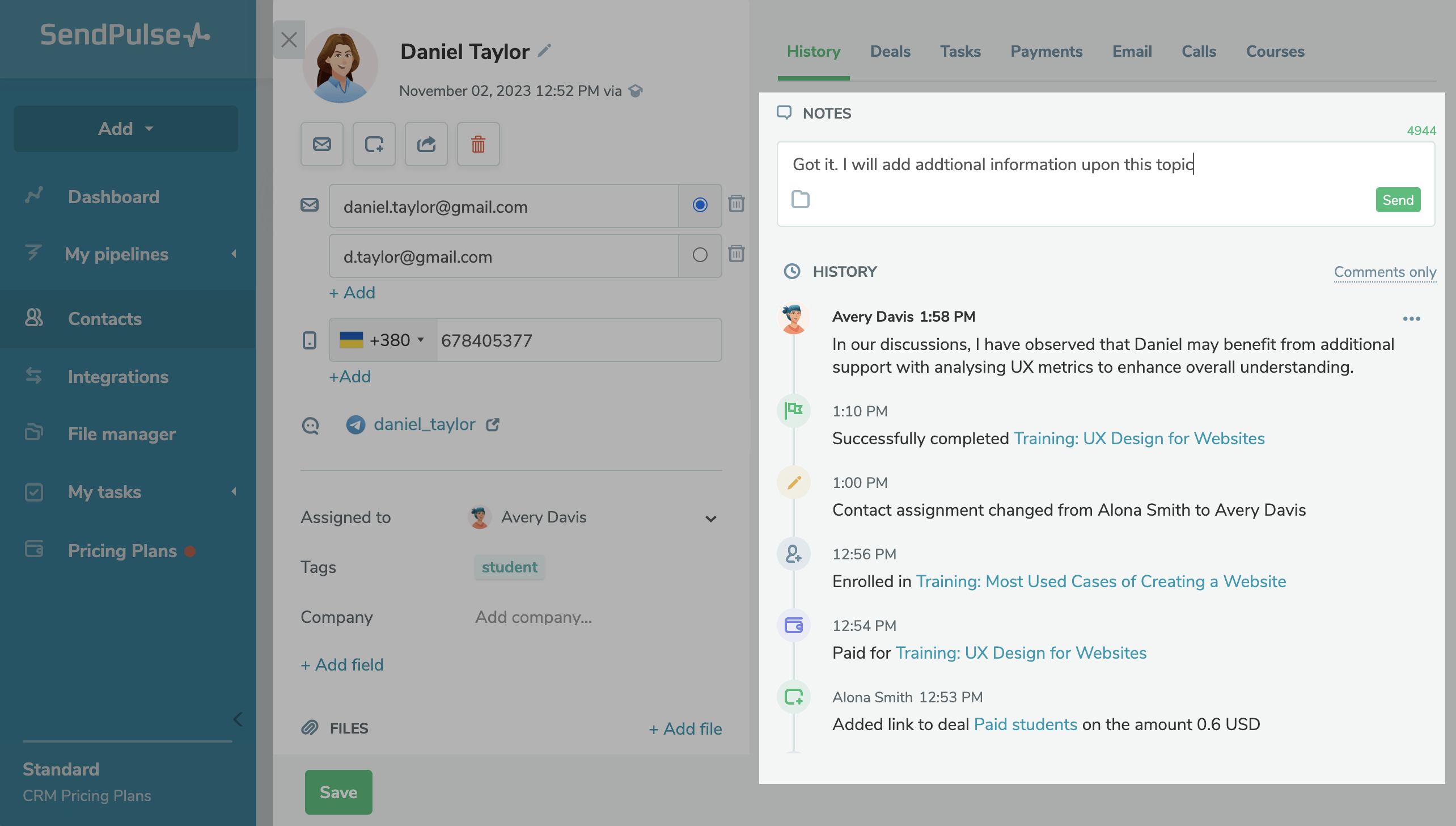
Deals
The "Deals" tab displays the list of deals associated with your selected contact. To add a new deal for the selected contact, click +Add deal.
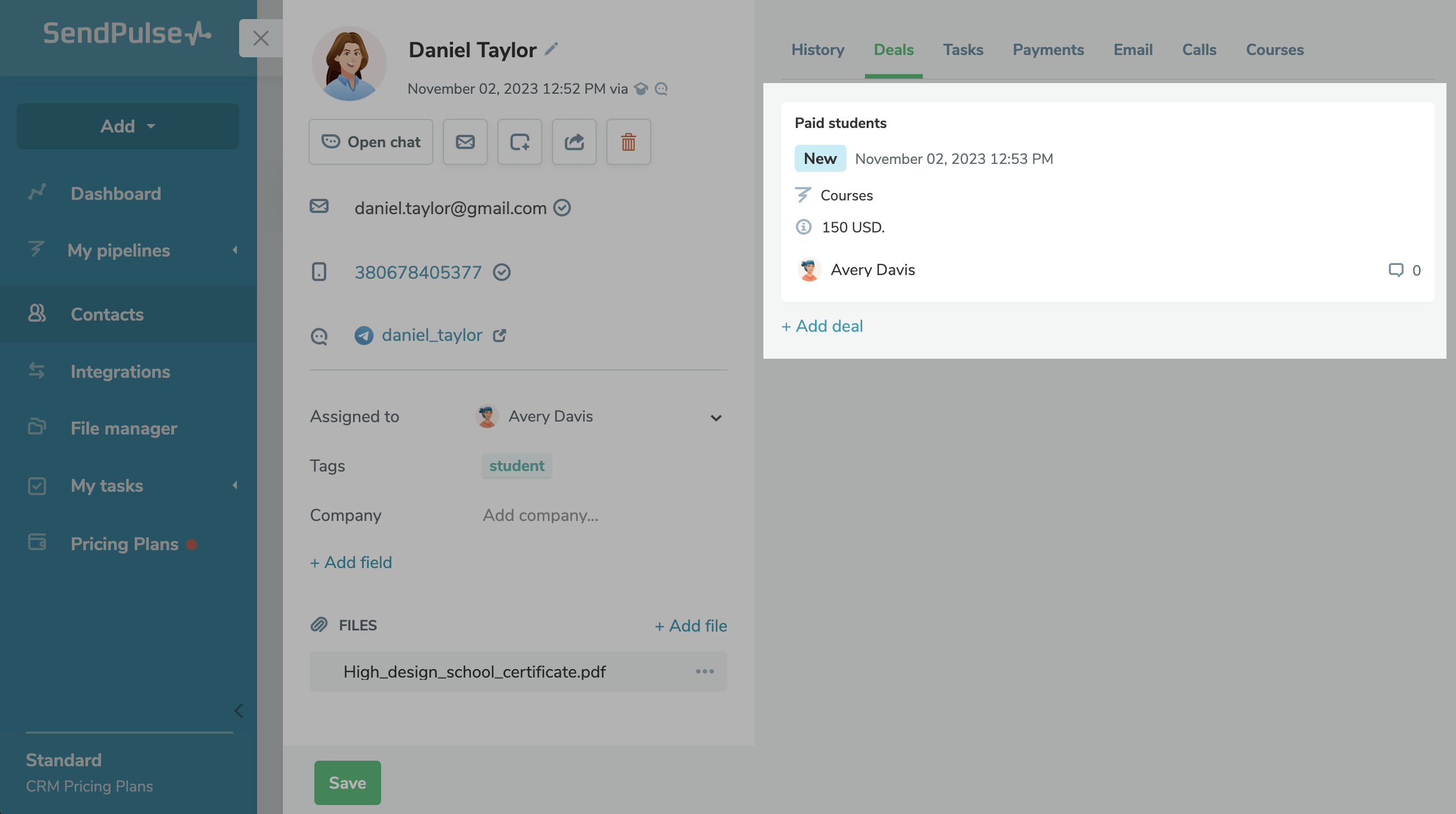
Enter the deal name and amount, and select the team member, deal stage, and deal type. Create new fields as needed. Click Add deal.
Learn more: How to Manage Deals.
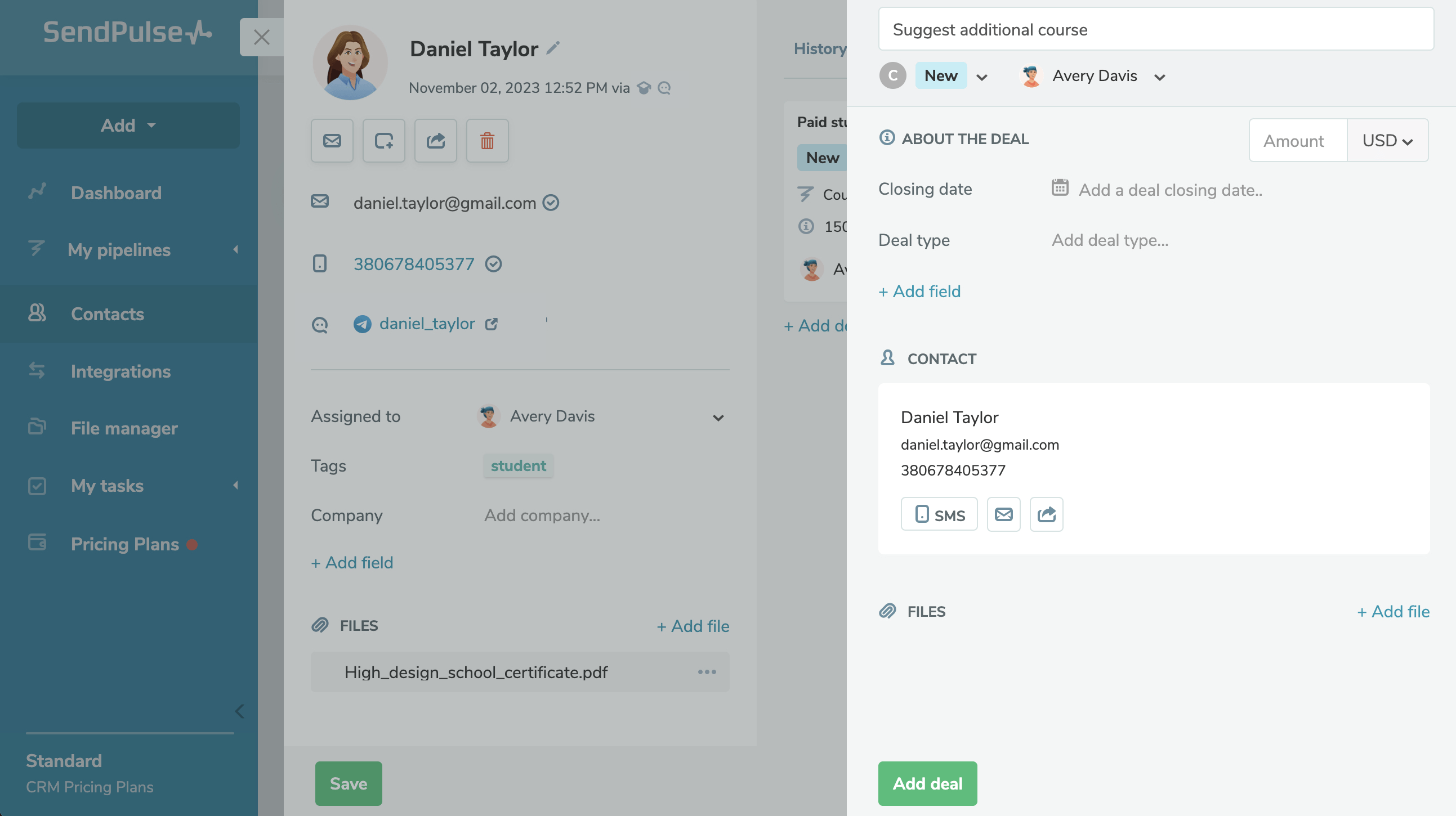
Tasks
In the “Tasks” tab, you can view your linked tasks or create a new one.
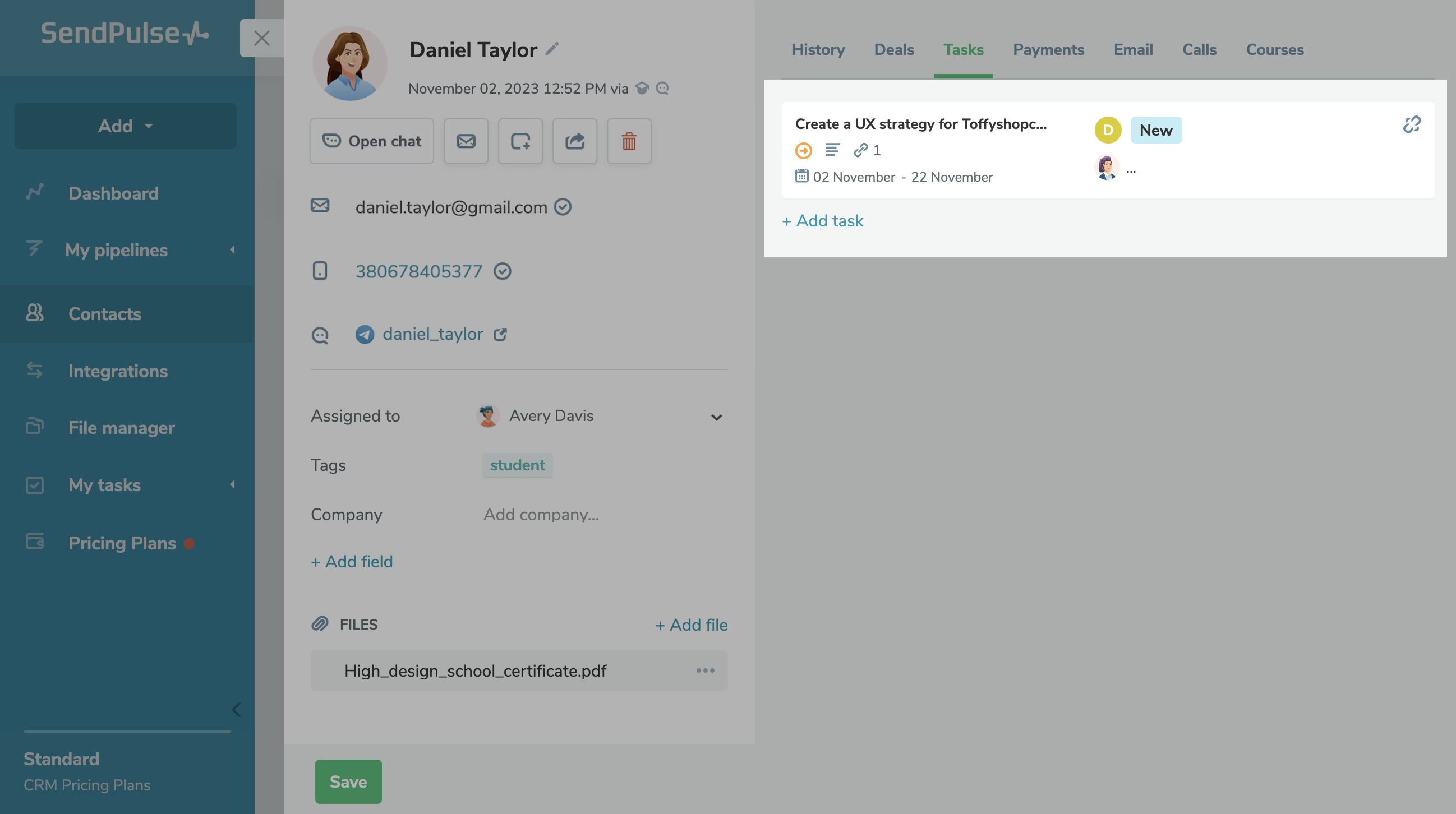
Enter your task name, fill in all the required fields, and click Add task.
Read also: How to Create a Task and How to Work with Tasks.
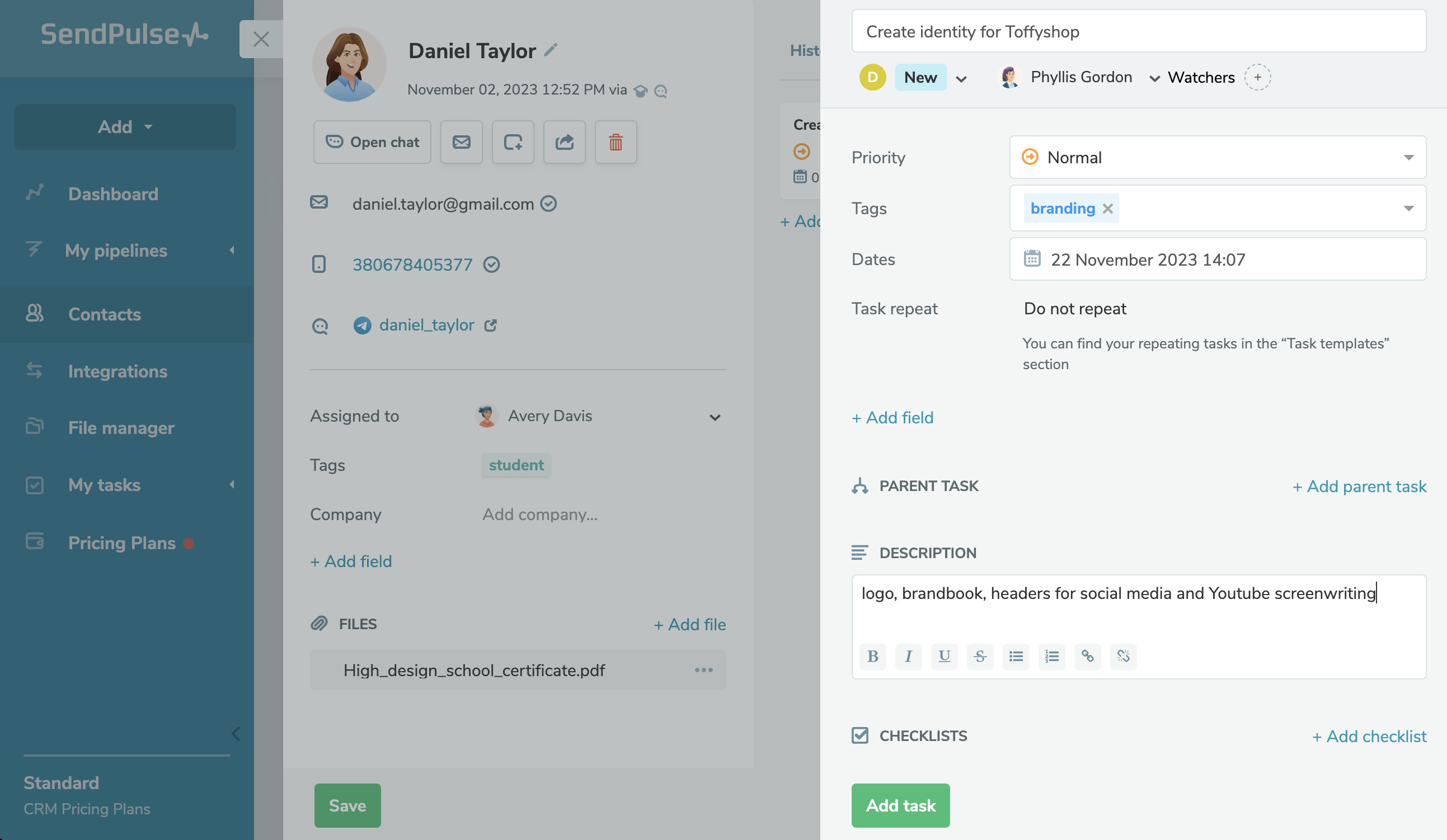
Your task will appear in the contact card. It will indicate your task’s title, status, due dates, and assignee. To edit a task or view it as a card, click it.
To unlink a task, click the unlink icon next to the task name.
Payments
In the "Payments" tab, you can see more information on the contact's payments: payment system, amount, description, status, and date.
The selected payment system provides details on all payment statuses. For more information, we recommend contacting your payment service provider’s support team.
Learn more: Sources of Automatically Added Deals: Payments.
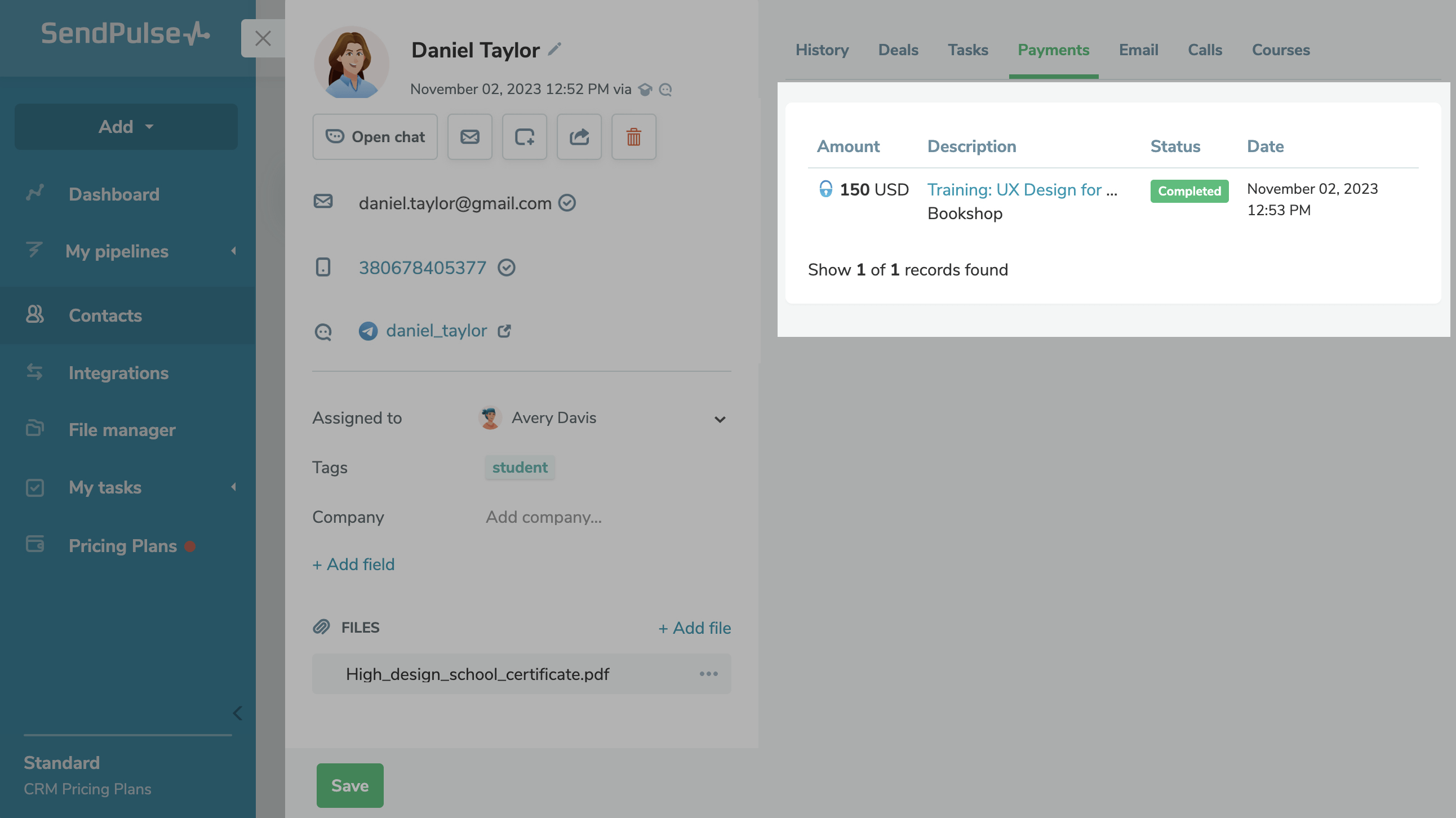
You can also generate payment links and share them with customers.
Read more: How to Generate Payment Links in CRM.
Courses
The "Courses" tab displays the courses for which the contact has registered, course progress, and the courses they have already taken.
Learn more: How to Manage Student Information.
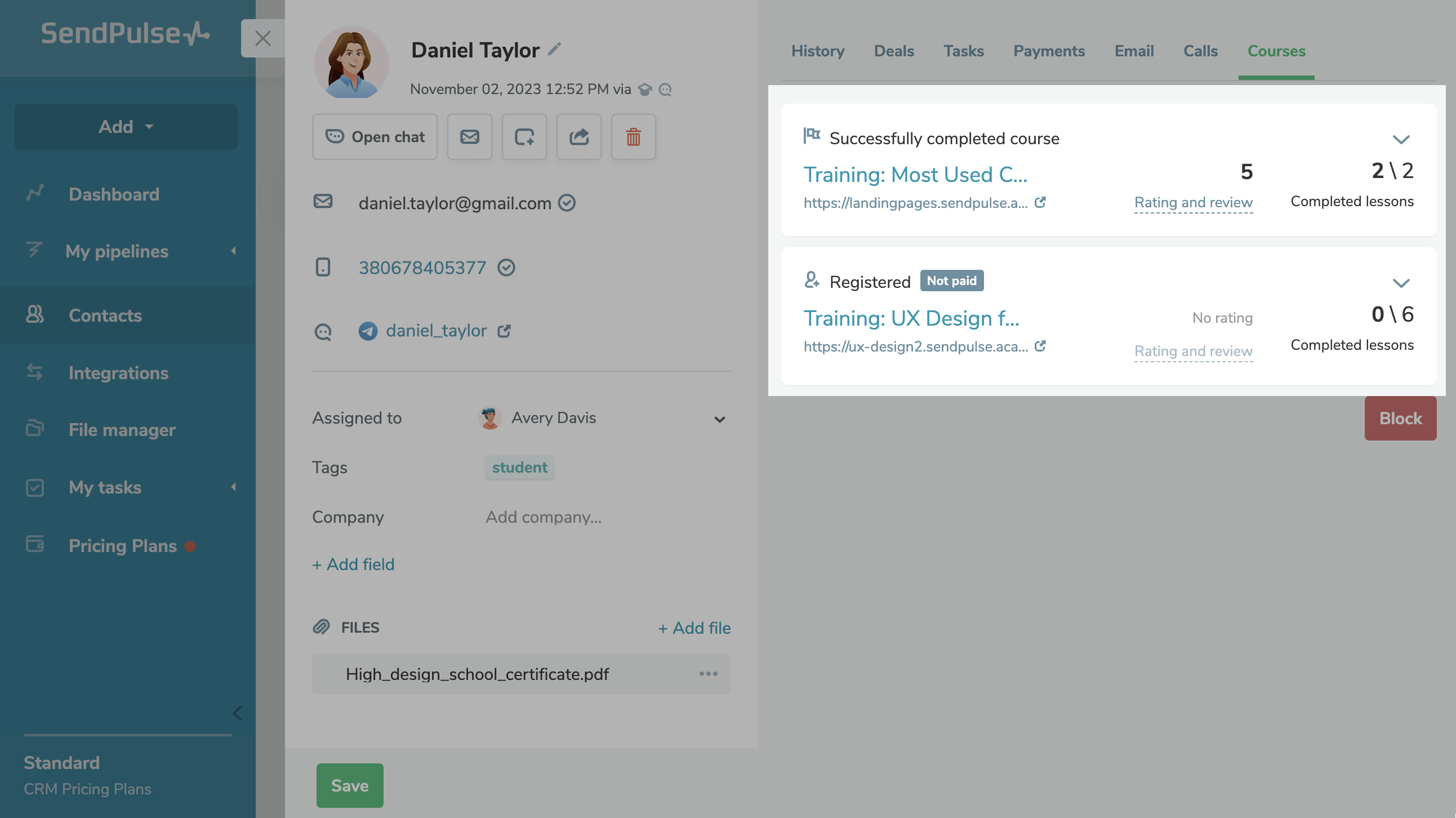
Calls
In the "Calls" tab, you can view the following client activity data: call date and time, duration, type (incoming, outgoing, missed), recording, and the manager who interacted with the client.
Learn more: How to Connect Binotel to Your CRM System.
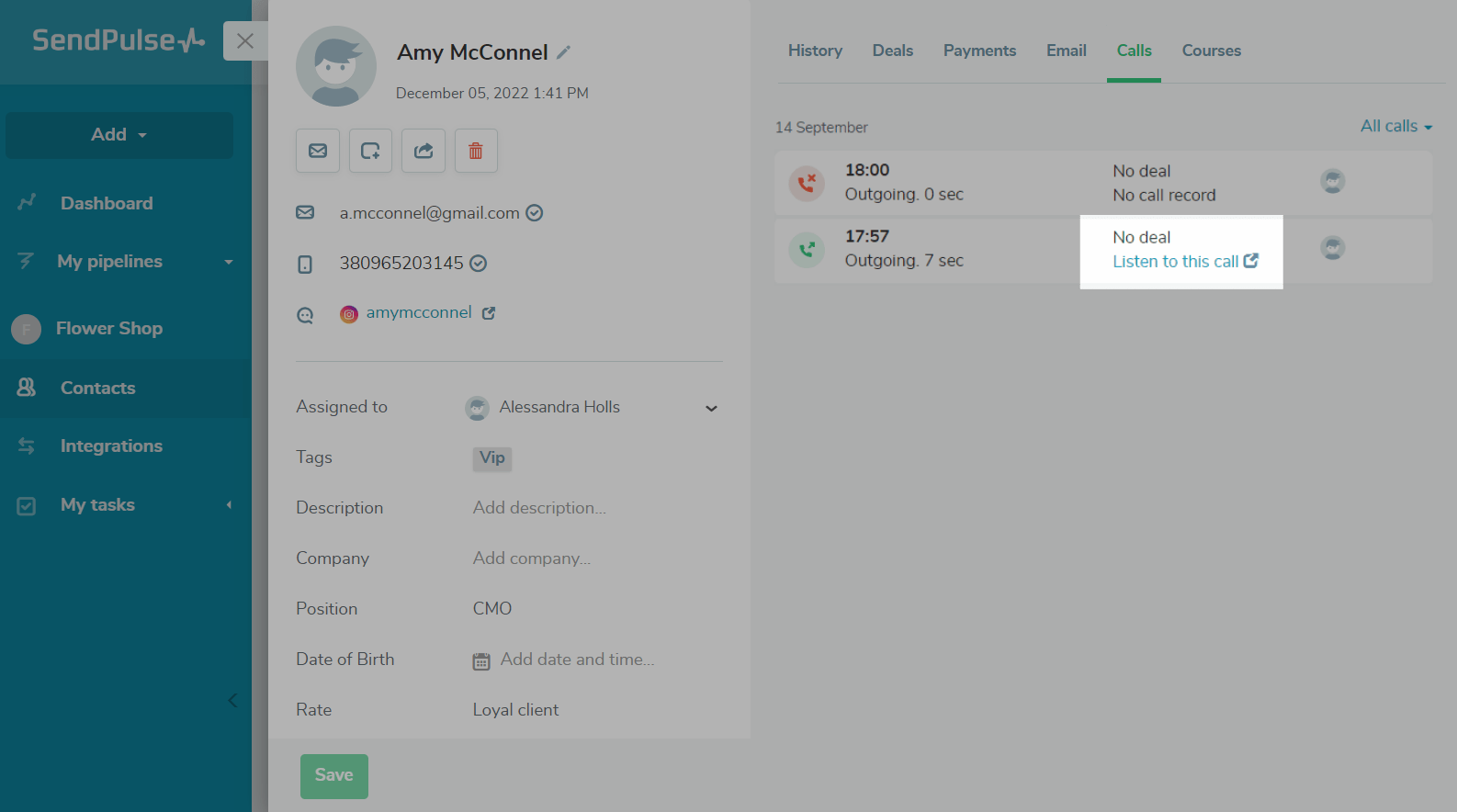
In the "Email" tab, you can connect the client's email address to CRM.
The "Email" tab is currently under development.
How to Go to the Contact Page
You can also go to the contact page to view more detailed information or edit data.
To do this, select your contact, and click on the "Contact details" icon.
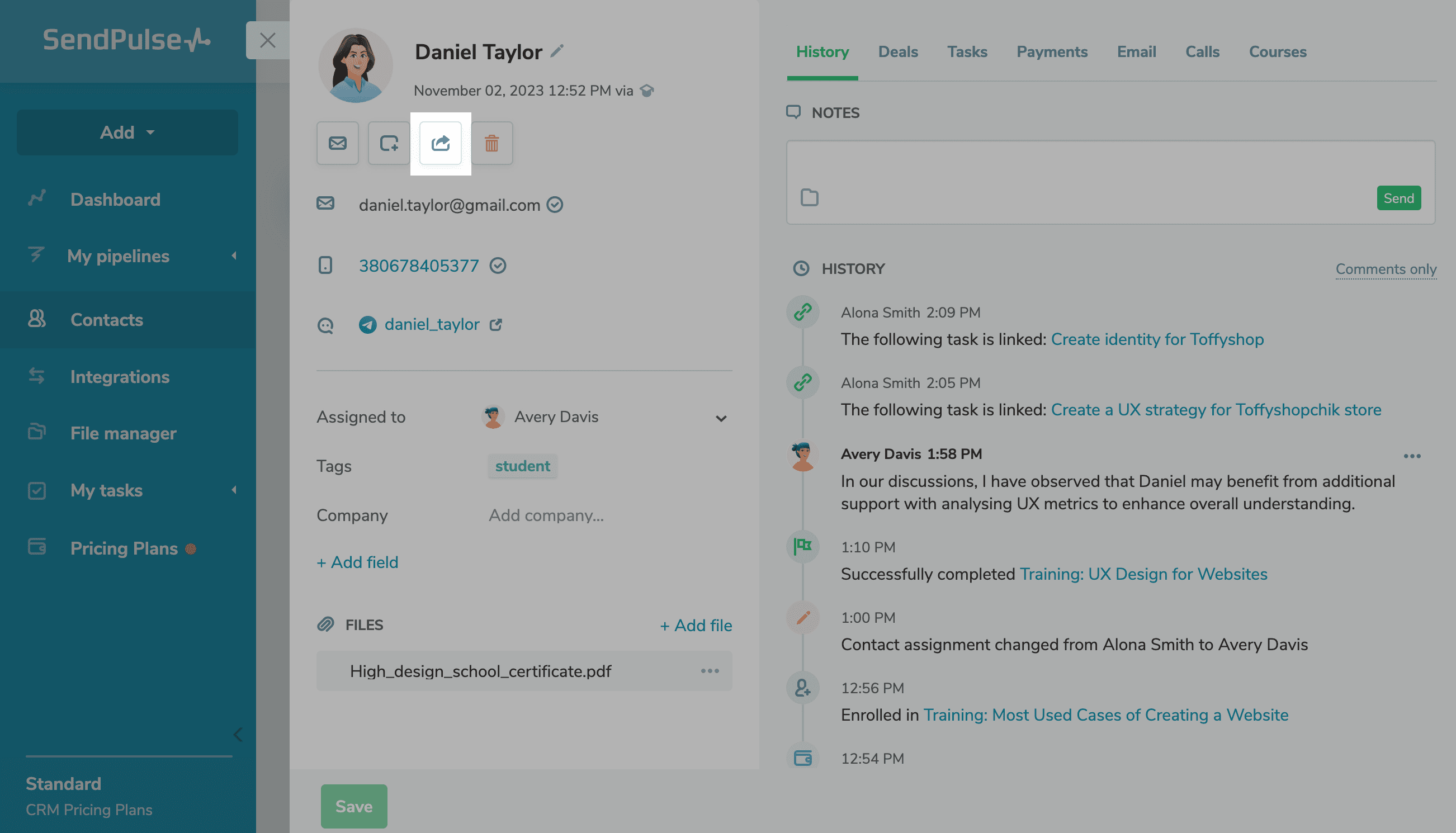
On the left, you can view or change your assignee’s first and last name and contact information, select a new assignee, and view and edit contact attributes.
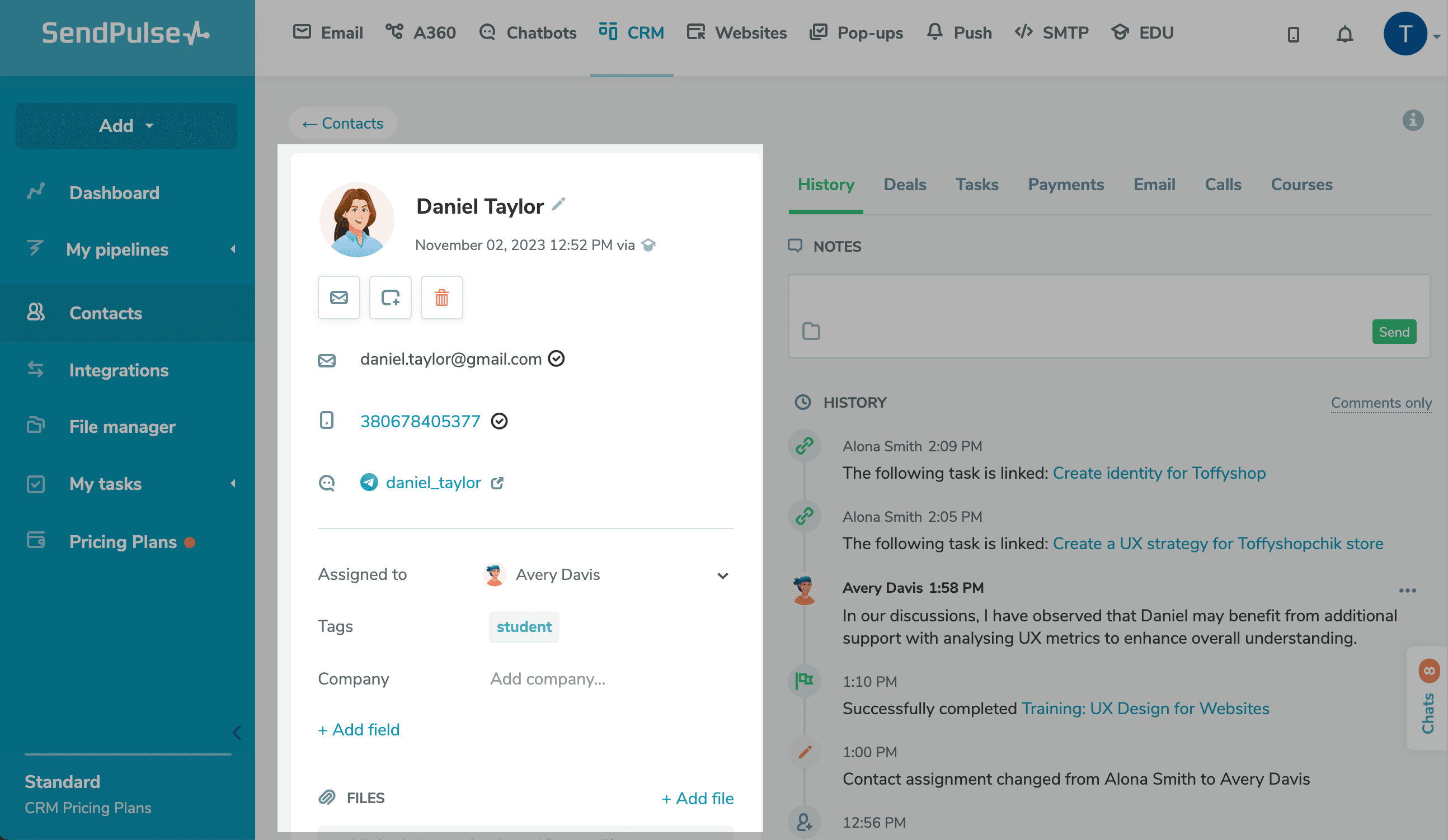
On the right, in the "History," "Deals," "Tasks," "Payments," "Email," "Calls," and "Courses" tabs, you can view and perform the actions discussed in the previous section.
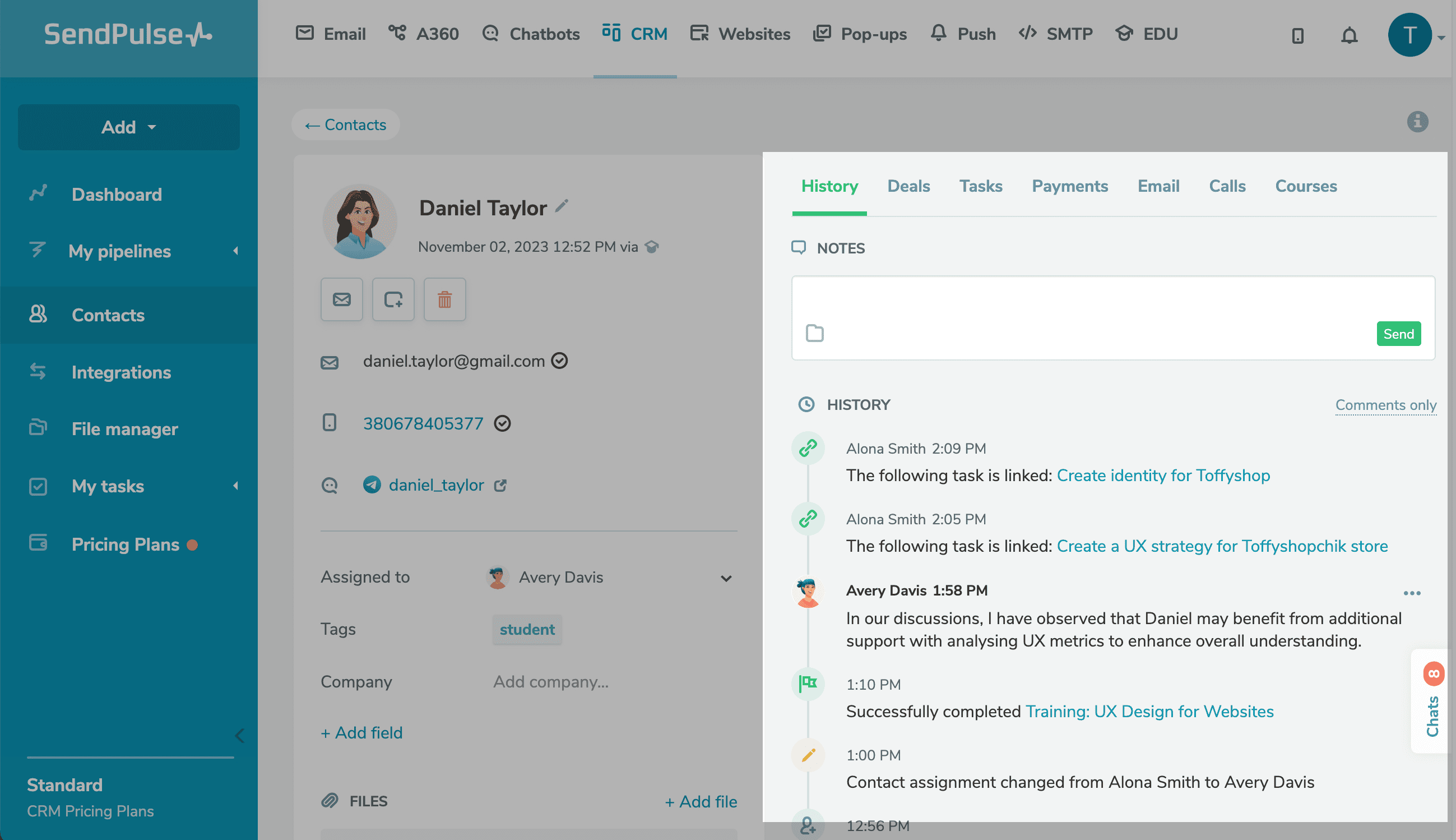
How to Reach a Client
You can reach out to the client directly from the contact card via chatbot or email.
The button "Send via chatbot" will be available if the contact is subscribed to one of your linked chatbots. Then you can click Open chat and go to the chat.
You can also send an email the contact — to do this, click Send email.
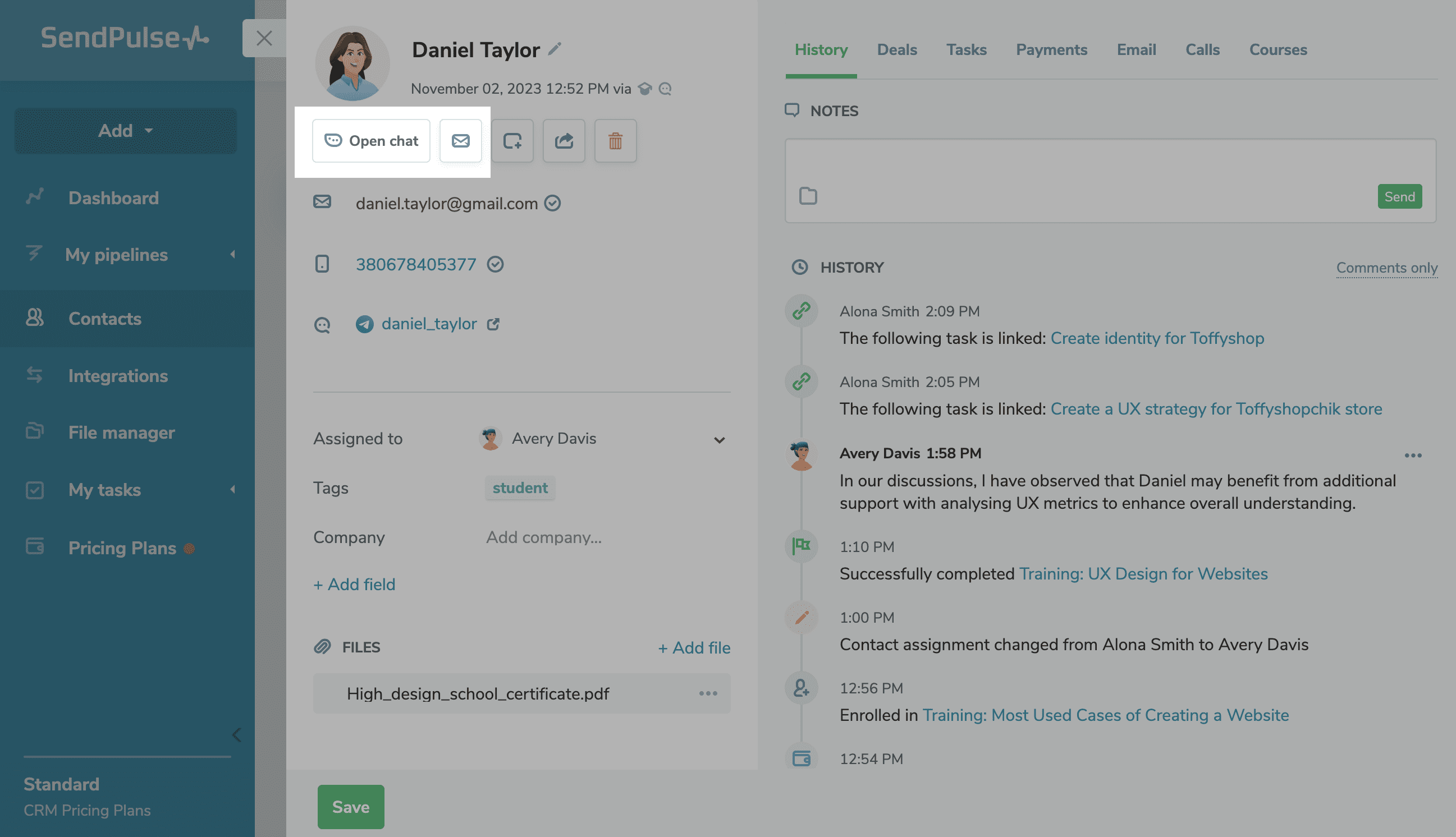
*The screenshot shows an example of a merged contact data transferred from the courses and chatbots.
When configuring the transfer of contacts to mailing lists, you can configure automations and filter segments using variables.
You can also use triggers and actions "Creating a deal" or "Changing deal status" to start automations.
Learn more: How to Send a Message Triggered by a CRM Event.
How to Set Up Contacts
To customize your contacts, go to "Contacts" > "Settings" section.
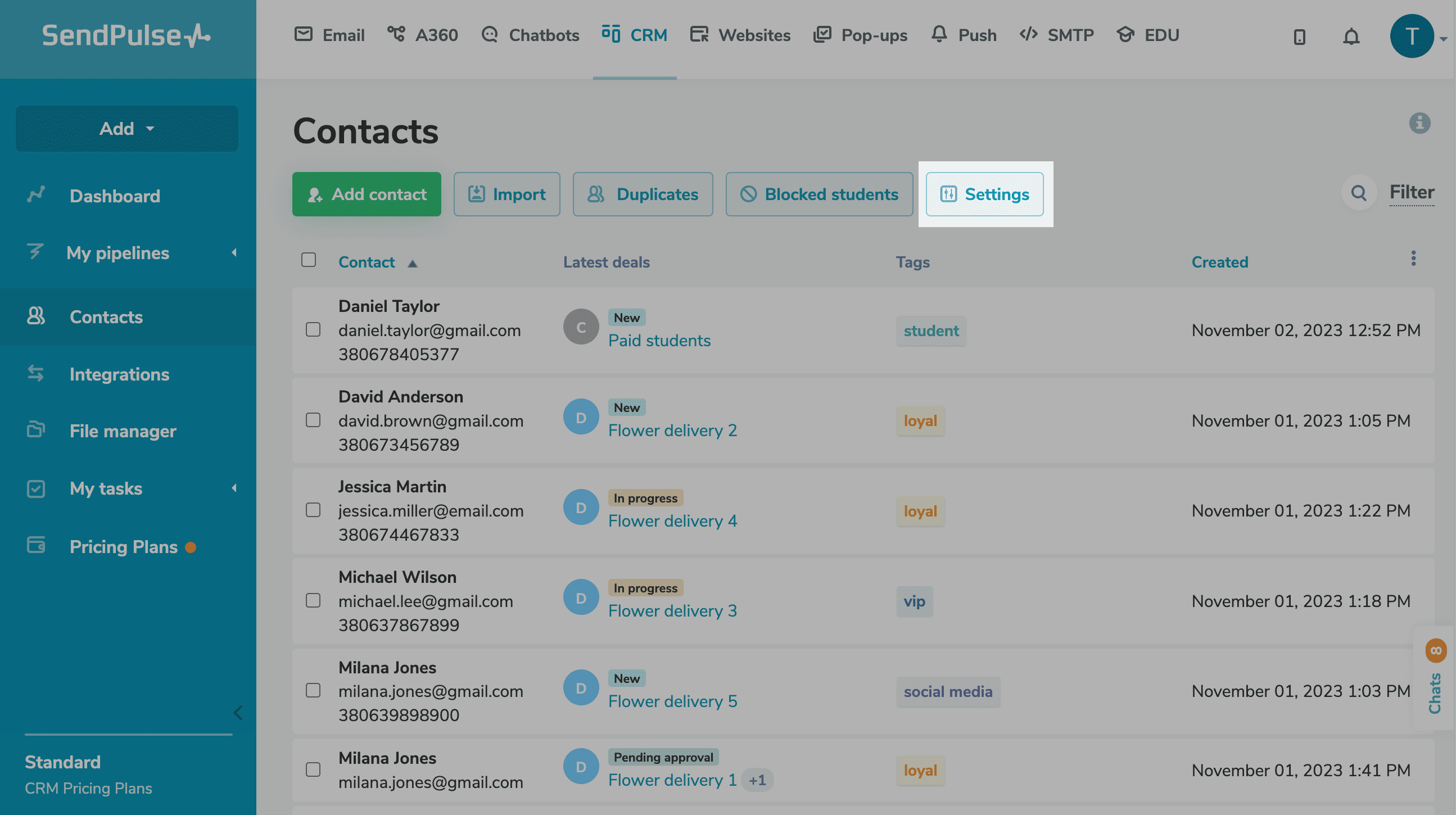
You can select a team member assigned to automatically added contacts, and customize fields and contact tags.
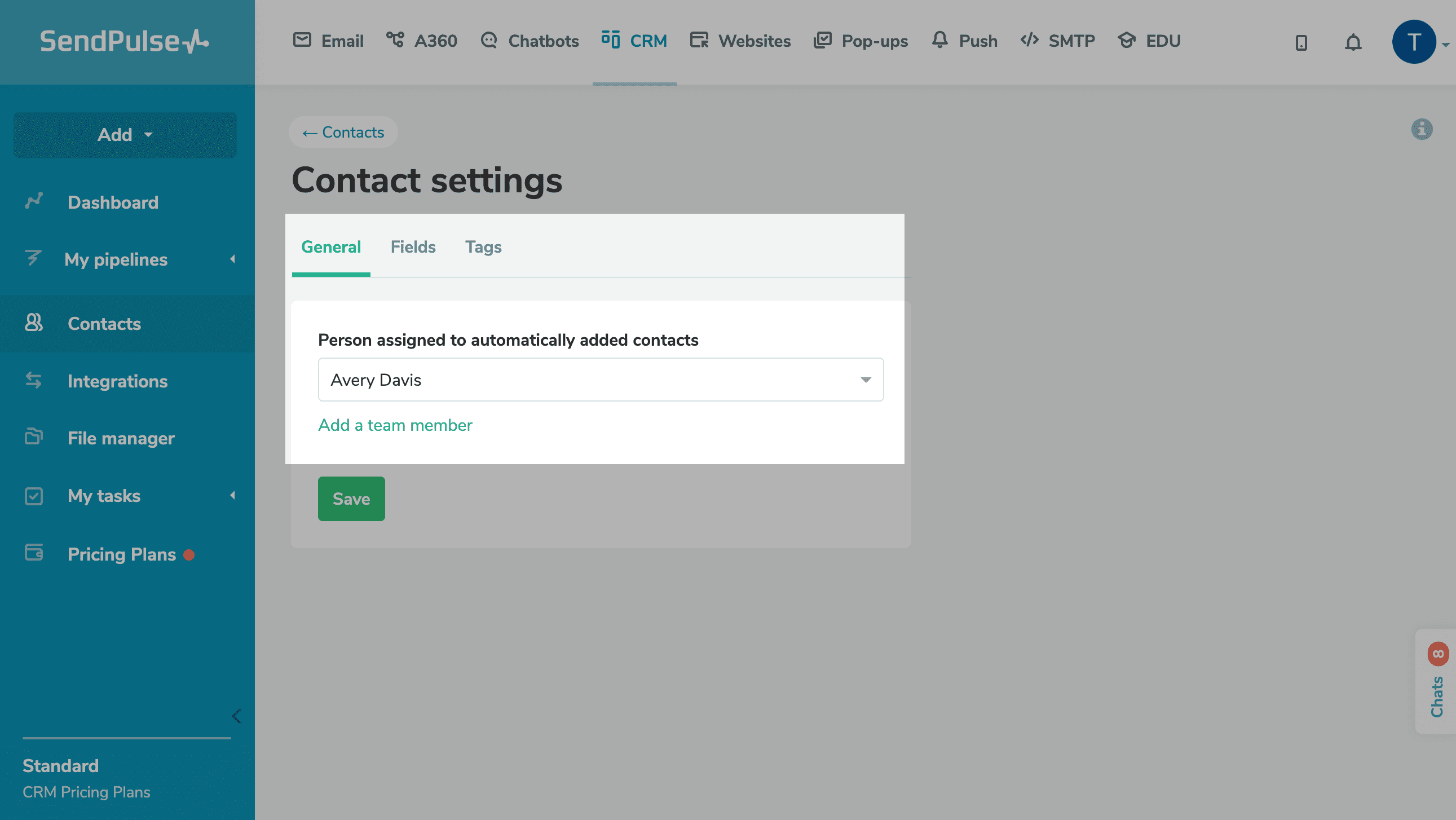
How to Export Contacts
You can export contacts manually or configure automatic exports of all your CRM contacts to a mailing list for bulk or automatic email campaigns.
Learn more: How to Export Contacts.
How to Block and Unblock a Course Contact
You can block student contacts from the Courses section so that they cannot re-register and take your courses. Also, blocked students are not included in your pricing plan.
After you block a student, the information about their course completion will be deleted from their contact card in the “CRM” section, and they will also be removed from your list of students in the “Courses” section. Your course will not be displayed in this student's account, and they will not be able to sign up for it on your course website.
If you want to add this student back to your course after unblocking them, send them an invitation through your personal account.
To block a student, open their card, and go to the "Courses" tab. Click Block. Then, confirm the action in the next window.
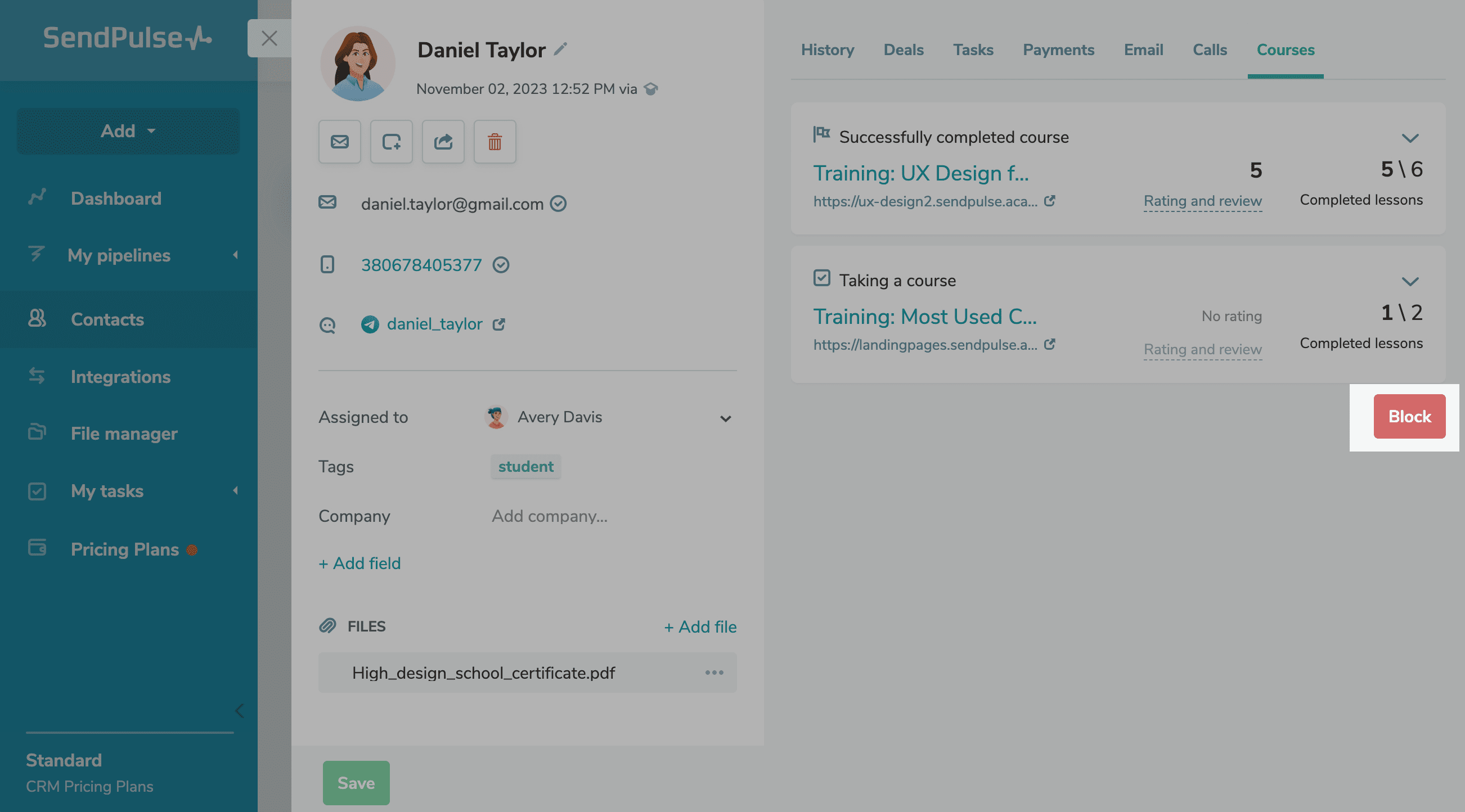
To unblock a student or view the list of blocked contacts, go to the “Blocked Students” tab. Also, using the filter, you can select students by certain parameters.
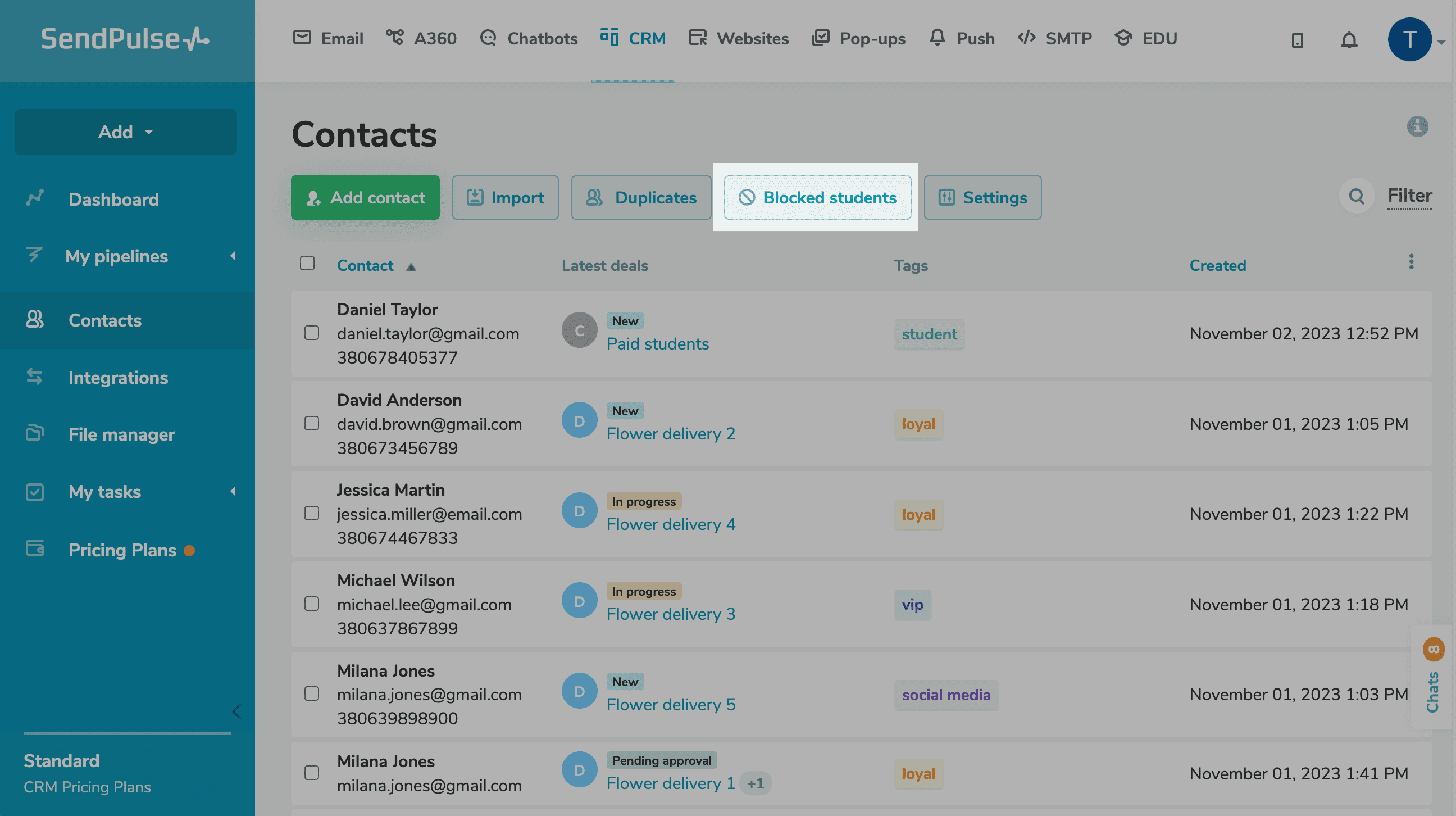
Find the necessary contact, and click Unblock.
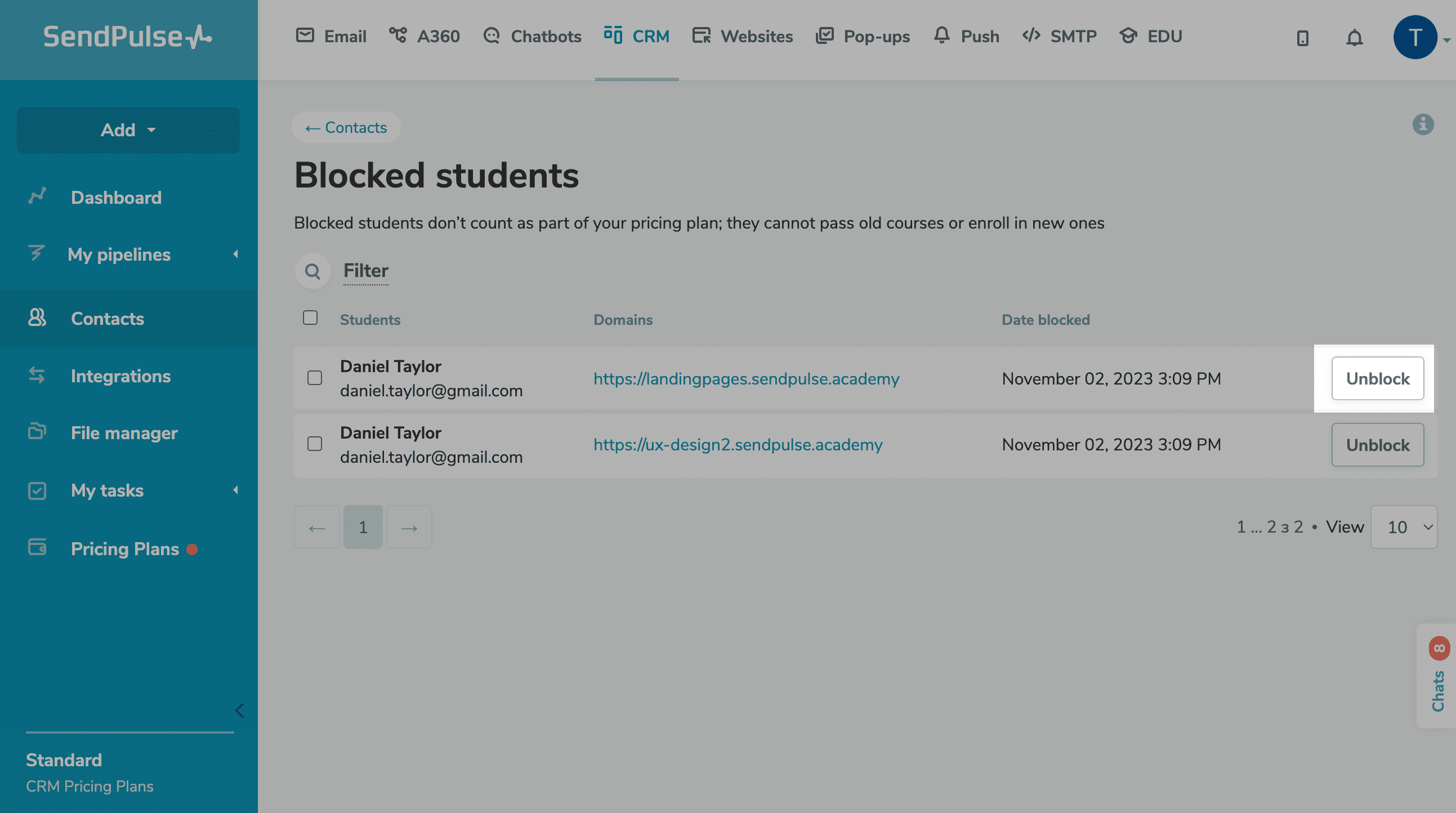
To unblock a student or view the list of blocked contacts, go to the “Blocked Students” tab. Also, using the filter, you can select students by certain parameters. Click Unblock.
Last Updated: 12.03.2024

or